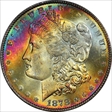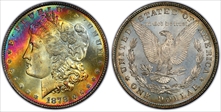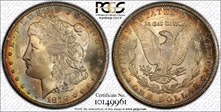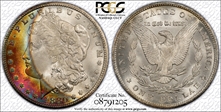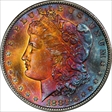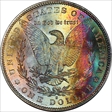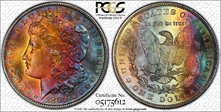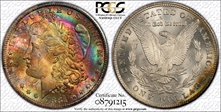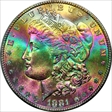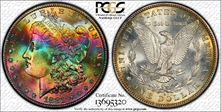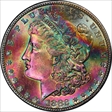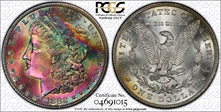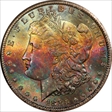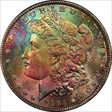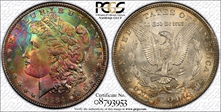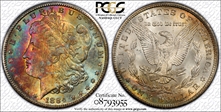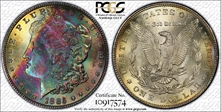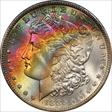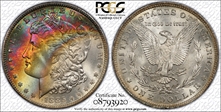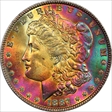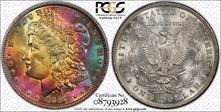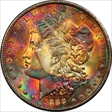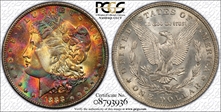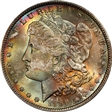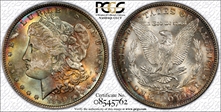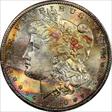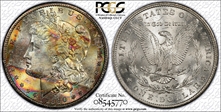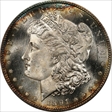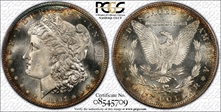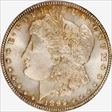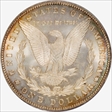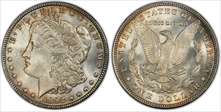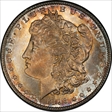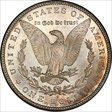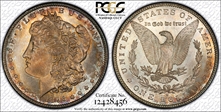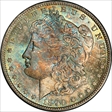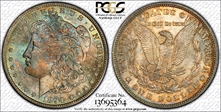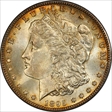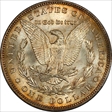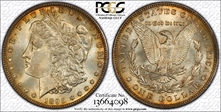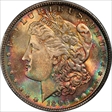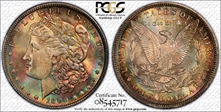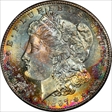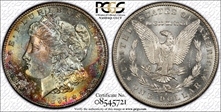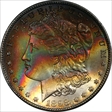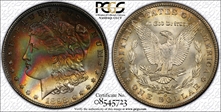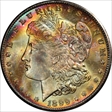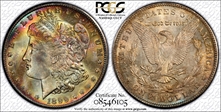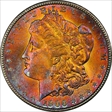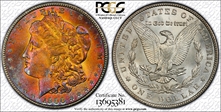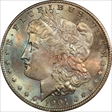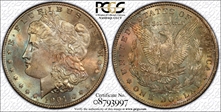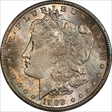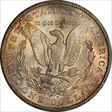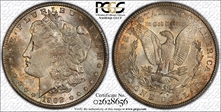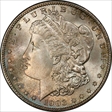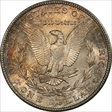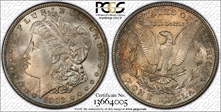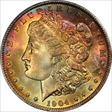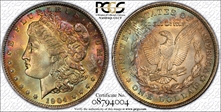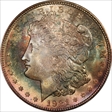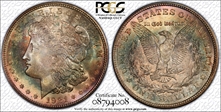Sunnywood's "Somewhere Over the Rainbow" Toned Morgans 的钱币相册
The popular "8TF" (eight tail feathers) variety marks the first adopted reverse for the new silver dollars of 1878. The design was later revised to seven tail feathers in accordance with Morgan's original intent, although the even number eight is actually more accurate. (According to Hawk Mountain's Research Center, most large birds of prey including the Bald Eagle have precisely 12 tail feathers, an even number.) This spectacular coin has some prooflike characteristics, exciting eye appeal, and PQ technical qualities - high end for the assigned grade. Ex Bowers & Merena, Baltimore (11/10/06:3521); previously ex Dale Larsen; Larry Shapiro; Superior, pre-Long Beach Sale (6/1/04:3105)
The popular "8TF" (eight tail feathers) variety marks the first adopted reverse for the new silver dollars of 1878. The design was later revised to seven tail feathers in accordance with Morgan's original intent, although the even number eight is actually more accurate. (According to Hawk Mountain's Research Center, most large birds of prey including the Bald Eagle have precisely 12 tail feathers, an even number.) This spectacular coin has some prooflike characteristics, exciting eye appeal, and PQ technical qualities - high end for the assigned grade. Ex Bowers & Merena, Baltimore (11/10/06:3521); previously ex Dale Larsen; Larry Shapiro; Superior, pre-Long Beach Sale (6/1/04:3105)
Very pretty classic rainbow bag toning highlighted by emerald hues graces this example of the 1878 dollar with the second adopted reverse, known to collectors as the "Reverse of '78". This reverse design features seven tail feathers ("7TF"), an ornithologically inaccurate account. The second reverse also features a flat to concave eagle's breast, and parallel arrow feathers on the adjacent fletches. As noted in our introduction to this set, the "Basic Circulation Strikes" Registry Set excludes the three important hub varieties, one of which is the 1878 7TF Reverse of '79 ("third reverse"). A toned example of that issue may be found in our "With Varieties" Registry set. This is the first of many coins in the Sunnywood Collection to have been acquired from or through dealer Mike DeFalco.
Very pretty classic rainbow bag toning highlighted by emerald hues graces this example of the 1878 dollar with the second adopted reverse, known to collectors as the "Reverse of '78". This reverse design features seven tail feathers ("7TF"), an ornithologically inaccurate account. The second reverse also features a flat to concave eagle's breast, and parallel arrow feathers on the adjacent fletches. As noted in our introduction to this set, the "Basic Circulation Strikes" Registry Set excludes the three important hub varieties, one of which is the 1878 7TF Reverse of '79 ("third reverse"). A toned example of that issue may be found in our "With Varieties" Registry set. This is the first of many coins in the Sunnywood Collection to have been acquired from or through dealer Mike DeFalco.
Lovely album toning of orange, rose, pink, blue and teal graces the obverse, while the reverse remains essentially untoned. One-sided toning is often found on bag-toned and end-of-roll coins, as well as some album-toned pieces. Other types of album storage may result in two-sided toning, which is also the norm on envelope-toned coins. (It was once commonplace for coin collections to be stored in individual 2x2" paper envelopes.) ANR, LaBelle Sale (7/25/05:1339).
Lovely album toning of orange, rose, pink, blue and teal graces the obverse, while the reverse remains essentially untoned. One-sided toning is often found on bag-toned and end-of-roll coins, as well as some album-toned pieces. Other types of album storage may result in two-sided toning, which is also the norm on envelope-toned coins. (It was once commonplace for coin collections to be stored in individual 2x2" paper envelopes.) ANR, LaBelle Sale (7/25/05:1339).
The unusual patchwork of green and rose colors on this coin are likely the result of end-of-roll toning. This coin is the best of four examples of the date we have owned thus far, but we are always searching for the "perfect" example that marries technical quality with beautiful obverse color. In forming the Sunnywood Collection, we had the good fortune of being able to "cherrypick" four collections that had been formed over a period of many years preceding. This coin was from one of those collections; it was one of a select group of beautifully toned coins acquired from fellow collector Dale Larsen.
The unusual patchwork of green and rose colors on this coin are likely the result of end-of-roll toning. This coin is the best of four examples of the date we have owned thus far, but we are always searching for the "perfect" example that marries technical quality with beautiful obverse color. In forming the Sunnywood Collection, we had the good fortune of being able to "cherrypick" four collections that had been formed over a period of many years preceding. This coin was from one of those collections; it was one of a select group of beautifully toned coins acquired from fellow collector Dale Larsen.
A beautifully and originally toned piece, this coin shows classic concentric album-toning on the reverse, while the obverse coloration is less symmetrical. This often happens in coin albums, as the reverse is safely nestled against the backing, while the obverse may be slightly more exposed to air flow. Notice the color intensifies along the upper perimeter of the obverse, signaling that there was slightly more exposure to ambient atmosphere there. Ex Bryan Orsborne (Texas Bullion Traders).
A beautifully and originally toned piece, this coin shows classic concentric album-toning on the reverse, while the obverse coloration is less symmetrical. This often happens in coin albums, as the reverse is safely nestled against the backing, while the obverse may be slightly more exposed to air flow. Notice the color intensifies along the upper perimeter of the obverse, signaling that there was slightly more exposure to ambient atmosphere there. Ex Bryan Orsborne (Texas Bullion Traders).
This is the most amazingly toned gem '79-P on the planet - and we have owned three of the best examples. The obverse features incredible thick rich emerald green, gold and rainbow bag toning. This kind of amazing color is virtually unheard-of on an 1879 P-mint, yet it is clearly 100% natural original bag toning. From the personal collection of dealer and long-time toned Morgan afficionado Jim Curtis, this coin was an unexpected treasure for Sunnywood to add to his collection. We also love our other 1879 PCGS MS66 coin, which is now gracing our Duplicates set, second only to this wondrous piece. We paid a huge premium for this coin without batting an eyelash - the coin is clearly worth every penny!
An important date that is rarely found with beautiful toning, this coin features a lovely rainbow of subtle yet distinctive pastel hues intensifying near the left obverse rim. Exceptional quality and eye appeal, and seemingly deserving of a higher grade. Easily among the very finest survivors of this key issue. Heritage, Dallas Signature Sale (12/10/04:1232); previously offered at ANR, Classics Sale Baltimore (3/10/04:1188).
An important date that is rarely found with beautiful toning, this coin features a lovely rainbow of subtle yet distinctive pastel hues intensifying near the left obverse rim. Exceptional quality and eye appeal, and seemingly deserving of a higher grade. Easily among the very finest survivors of this key issue. Heritage, Dallas Signature Sale (12/10/04:1232); previously offered at ANR, Classics Sale Baltimore (3/10/04:1188).
Not only is this the most exceptionally colored 1879-O that we have ever seen, but it is also superior in technical quality to the two PCGS MS65 examples that we have owned. In cases like this, we are willing to sacrifice Registry ranking to include a superior coin, even if the slab grade is a point lower than our other candidates. A favorite acquisition from long-time toned Morgan collector Dale Larsen.
Not only is this the most exceptionally colored 1879-O that we have ever seen, but it is also superior in technical quality to the two PCGS MS65 examples that we have owned. In cases like this, we are willing to sacrifice Registry ranking to include a superior coin, even if the slab grade is a point lower than our other candidates. A favorite acquisition from long-time toned Morgan collector Dale Larsen.
A stellar superb gem classic banded rainbow toner. This type of toning is unique to Morgan dollars that were stored undisturbed for decades in bank vaults. The rainbow bands are a hallmark of natural toning, and also teach us volumes about the role of thin film deposition and refraction of light in creating colorful toning. The color progression that is plainly visible on a banded rainbow-toned coin is a roadmap to understanding and recognizing authentic natural toning. Ex Mike DeFalco (Numismatic Enterprises); Michael Page.
A stellar superb gem classic banded rainbow toner. This type of toning is unique to Morgan dollars that were stored undisturbed for decades in bank vaults. The rainbow bands are a hallmark of natural toning, and also teach us volumes about the role of thin film deposition and refraction of light in creating colorful toning. The color progression that is plainly visible on a banded rainbow-toned coin is a roadmap to understanding and recognizing authentic natural toning. Ex Mike DeFalco (Numismatic Enterprises); Michael Page.
A date that is often found with blue and rose toning, here is an exceptionally clean envelope-toned example. In the progression of toning colors caused by the thin-film interference effect produced by the toning layer, the initial toning colors are light gold, medium gold, amber, russet, burgundy, cobalt blue, and pale cyan blue. Coins in the burgundy-to-blue portion of the progression exhibit the colors seen here. Ex Heritage, Long Beach Signature Sale (6/3/05:6747).
A date that is often found with blue and rose toning, here is an exceptionally clean envelope-toned example. In the progression of toning colors caused by the thin-film interference effect produced by the toning layer, the initial toning colors are light gold, medium gold, amber, russet, burgundy, cobalt blue, and pale cyan blue. Coins in the burgundy-to-blue portion of the progression exhibit the colors seen here. Ex Heritage, Long Beach Signature Sale (6/3/05:6747).
A beautiful example of crescent rainbow bag toning, which is the result of another silver dollar lying on top of a portion of the obverse of this coin during years of bank-vault storage in the original Mint burlap bag. The covered portion of the obverse remained untined, while the exposed portion developed the colorful toning seen here. On this coin, the bands of tan, blue and yellow are narrow, while the red-orange band broadens to dominate the toned area. The crescent is also placed in the most desirable location: on the obverse, and lighting up Miss Liberty's face with color. Combine this with frosty lustrous premium gem Carson City surfaces, and you get a winner suitable for inclusion in this set. Ex Jason Stevens.
A beautiful example of crescent rainbow bag toning, which is the result of another silver dollar lying on top of a portion of the obverse of this coin during years of bank-vault storage in the original Mint burlap bag. The covered portion of the obverse remained untined, while the exposed portion developed the colorful toning seen here. On this coin, the bands of tan, blue and yellow are narrow, while the red-orange band broadens to dominate the toned area. The crescent is also placed in the most desirable location: on the obverse, and lighting up Miss Liberty's face with color. Combine this with frosty lustrous premium gem Carson City surfaces, and you get a winner suitable for inclusion in this set. Ex Jason Stevens.
The first of an exceptional group of toned Morgan dollars purchased from the "Toned Dollars" Collection owned by our friend Jack kelly, this coin is PQ for the MS64 grade, and has pleasant obverse toning coupled with a similarly good-looking reverse. (In the Sunnywood Collection, the requirement is obverse color, but we are always happy to acquire "two-sided" toners that also have nice color on the reverse.) This date becomes notoriously tough as one approaches gem quality. As far as we know, there are *NO* attractively toned examples graded MS65 or higher, so a beautiful colorful PQ two-sided MS64 is the best that can be found.
The first of an exceptional group of toned Morgan dollars purchased from the "Toned Dollars" Collection owned by our friend Jack kelly, this coin is PQ for the MS64 grade, and has pleasant obverse toning coupled with a similarly good-looking reverse. (In the Sunnywood Collection, the requirement is obverse color, but we are always happy to acquire "two-sided" toners that also have nice color on the reverse.) This date becomes notoriously tough as one approaches gem quality. As far as we know, there are *NO* attractively toned examples graded MS65 or higher, so a beautiful colorful PQ two-sided MS64 is the best that can be found.
One of the highlights of Sunnywood's "Somewhere Over the Rainbow" toned Morgan dollar collection; an extraordinary and record-setting example of an otherwise common date; this technically superb monster features an intensely toned obverse with blues, pinks and true gold, miraculously paired with lustrous classic vertically banded rainbow toning on the reverse. The left-to-right toning progression on both sides corresponds perfectly directionally, indicating that the two-sided toning likely formed simultaneously during decades of Mint bag storage. The obverse occupies a narrower band of the color progression than the reverse, showing that the air flow characteristic across the surface was different for the two sides. Perhaps the reverse lay facing up in the Mint bag, but the coin was propped up at the rim, thus allowing limited air flow across the obverse as well. The coin had the exact same appearance when it was sold at auction in 1983, proving that the toning is highly stable and formed naturally over a long period. Ex RARCOA, Auction '83 (7/83:1182); held in one collection for 23 years; ANR, New York Connoisseur's Collection Sale (3/14/06:1147).
One of the highlights of Sunnywood's "Somewhere Over the Rainbow" toned Morgan dollar collection; an extraordinary and record-setting example of an otherwise common date; this technically superb monster features an intensely toned obverse with blues, pinks and true gold, miraculously paired with lustrous classic vertically banded rainbow toning on the reverse. The left-to-right toning progression on both sides corresponds perfectly directionally, indicating that the two-sided toning likely formed simultaneously during decades of Mint bag storage. The obverse occupies a narrower band of the color progression than the reverse, showing that the air flow characteristic across the surface was different for the two sides. Perhaps the reverse lay facing up in the Mint bag, but the coin was propped up at the rim, thus allowing limited air flow across the obverse as well. The coin had the exact same appearance when it was sold at auction in 1983, proving that the toning is highly stable and formed naturally over a long period. Ex RARCOA, Auction '83 (7/83:1182); held in one collection for 23 years; ANR, New York Connoisseur's Collection Sale (3/14/06:1147).
One of the highlights of Sunnywood's "Somewhere Over the Rainbow" toned Morgan dollar collection; an extraordinary and record-setting example of an otherwise common date; this technically superb monster features an intensely toned obverse with blues, pinks and true gold, miraculously paired with lustrous classic vertically banded rainbow toning on the reverse. The left-to-right toning progression on both sides corresponds perfectly directionally, indicating that the two-sided toning likely formed simultaneously during decades of Mint bag storage. The obverse occupies a narrower band of the color progression than the reverse, showing that the air flow characteristic across the surface was different for the two sides. Perhaps the reverse lay facing up in the Mint bag, but the coin was propped up at the rim, thus allowing limited air flow across the obverse as well. The coin had the exact same appearance when it was sold at auction in 1983, proving that the toning is highly stable and formed naturally over a long period. Ex RARCOA, Auction '83 (7/83:1182); held in one collection for 23 years; ANR, New York Connoisseur's Collection Sale (3/14/06:1147).
A very beautiful and colorful album-toned piece from Sanders Trading Co., this coin was graded MS66* by NGC. We agree with the MS66 designation, and feel that PCGS was a bit conservative here. The toning break in the left obverse field (the pewter area) is a hallmark of authenticity, and does not detract from the beauty of this piece.
A very beautiful and colorful album-toned piece from Sanders Trading Co., this coin was graded MS66* by NGC. We agree with the MS66 designation, and feel that PCGS was a bit conservative here. The toning break in the left obverse field (the pewter area) is a hallmark of authenticity, and does not detract from the beauty of this piece.
A monster bag-toned example of this classic date from the GSA sales of Cqarson City Morgan dollars. This coin features beautiful rich obverse toning, including an area of classic emerald green. We have never seen a more attractive '81-CC. Note the interesting ghost image of a piece of canvas thread under Miss Liberty's chin and on her neck, caused by a thread from the Mint bag canvas fabric lying across the surface of the coin for decades while the coin toned. From Mike DeFalco (Numismatic Enterprises).
A monster bag-toned example of this classic date from the GSA sales of Cqarson City Morgan dollars. This coin features beautiful rich obverse toning, including an area of classic emerald green. We have never seen a more attractive '81-CC. Note the interesting ghost image of a piece of canvas thread under Miss Liberty's chin and on her neck, caused by a thread from the Mint bag canvas fabric lying across the surface of the coin for decades while the coin toned. From Mike DeFalco (Numismatic Enterprises).
Truly a monster toned 1881-O, this PQ gem is the best of five colorful examples of this date that we have owned. By consensus, it is also the best '81-O any toned dollar specialist has ever seen. The obverse is blanketed with deep but attractive shades of deep magenta, purple, eggplant, deep blues and greens, and golds, such as could only have formed during decades of absolutely undisturbed storage in the original Mint bag. Ex Jack Kelly's "Toned Dollars" collection. Jack called this coin "The Purple People-Eater" and it was one of his favorites, along with his 1921-P (now also part of the Sunnywood Collection). We paid record premiums to pry these prize coins away, but they were worth it!
Truly a monster toned 1881-O, this PQ gem is the best of five colorful examples of this date that we have owned. By consensus, it is also the best '81-O any toned dollar specialist has ever seen. The obverse is blanketed with deep but attractive shades of deep magenta, purple, eggplant, deep blues and greens, and golds, such as could only have formed during decades of absolutely undisturbed storage in the original Mint bag. Ex Jack Kelly's "Toned Dollars" collection. Jack called this coin "The Purple People-Eater" and it was one of his favorites, along with his 1921-P (now also part of the Sunnywood Collection). We paid record premiums to pry these prize coins away, but they were worth it!
Considered by some enthusiasts to be the ultimate finest toned Morgan known to the collecting community, this paradigm of perfection features rich vibrant banded rainbow toning over essentially flawless and highly lustrous surfaces. This coin was the favorite centerpiece of longtime collector extraordinaire Ron Sirna, whose love of beautifully toned coins led him to found the Toned Coin Collectors Society. The "Sirna Moose" starred solo in full-page color ad campaign by ANACS (whien the coin was in an ANACS MS68 holder), and is also the centerpiece of a beautiful poster created by Ron for the Toned Coin Collectors Society. Although the 1881-S is arguably the most common date in the series both generally and with color, this specimen sits at the pinnacle of the many surviving examples, and is a highlight of The Sunnywood Collection.
Considered by some enthusiasts to be the ultimate finest toned Morgan known to the collecting community, this paradigm of perfection features rich vibrant banded rainbow toning over essentially flawless and highly lustrous surfaces. This coin was the favorite centerpiece of longtime collector extraordinaire Ron Sirna, whose love of beautifully toned coins led him to found the Toned Coin Collectors Society. The "Sirna Moose" starred solo in full-page color ad campaign by ANACS (whien the coin was in an ANACS MS68 holder), and is also the centerpiece of a beautiful poster created by Ron for the Toned Coin Collectors Society. Although the 1881-S is arguably the most common date in the series both generally and with color, this specimen sits at the pinnacle of the many surviving examples, and is a highlight of The Sunnywood Collection.
It is surprisingly difficult to find an attractively toned '82-P dollar at the PCGS MS66 quality level, and examples appearing at auction have accordingly performed quite well. The coin in our duplicates set, for example, was purchased as an NGC MS66*, but downgraded to PCGS MS65 on crossover. The present example features beautiful bright blue peripheral album toning, with a nice classic target pattern on the obverse. This is the best toned '82-P we have seen, when considering both technical quality and color. From Stack's, El Dorado Sale (5/14/09:549, $4025).
Classic rainbow bag toning graces the obverse of this Carson City dollar. Whereas album toned coins follow the thin-film interference color progressoin radially from the centers outwards, bag-toned Morgans often exhibit a somewhat linear trajectory of the color progression across the surface of the coin. In this case the lowest degree of toning occurs at about 9 o`clock on the obverse, and the colors progress thence left to right across the surface, moving from amber and burgundy tones, through the cyan and lemon yellow, and into magenta with a bit of blue-green at the extreme right perimeter. A bit of mottling in the toning, easily seen in the left field, is typical of GSA CC dollars. From one-time toned dollar dealer Jason Stevens.
Classic rainbow bag toning graces the obverse of this Carson City dollar. Whereas album toned coins follow the thin-film interference color progressoin radially from the centers outwards, bag-toned Morgans often exhibit a somewhat linear trajectory of the color progression across the surface of the coin. In this case the lowest degree of toning occurs at about 9 o`clock on the obverse, and the colors progress thence left to right across the surface, moving from amber and burgundy tones, through the cyan and lemon yellow, and into magenta with a bit of blue-green at the extreme right perimeter. A bit of mottling in the toning, easily seen in the left field, is typical of GSA CC dollars. From one-time toned dollar dealer Jason Stevens.
The last of the early New Orleans issues less commonly seen with toning, this coin features rich toning with an interesting thin pink line that traverses the obverse, perhaps caused by a rubber band during years of storage; from Mike DeFalco (Numismatic Enterprises).
The last of the early New Orleans issues less commonly seen with toning, this coin features rich toning with an interesting thin pink line that traverses the obverse, perhaps caused by a rubber band during years of storage; from Mike DeFalco (Numismatic Enterprises).
Featured on the front of the color brochure prepared by PCGS for the display of the Sunnywood Collection, this coin was chosen most often as the favorite in the set by collectors who visited the display. It was once dubbed "The Electric Rainbow Wonder Coin" by Morgan dollar specialist Michael Casper. Like the 1879-S, 1880-S and 1881-S dollars in the set, this spectacular coin is an exceptionally beautiful and technically superb example of what would otherwise be a common date San Francisco Morgan dollar. From the collection of our friend Gregg Bingham, who also happens to be a well-known former Houston Oilers middle linebacker, and a world-class coin collector. Gregg's "NFL Set" was one of the best collections of Morgans ever to be sold at auction (Heritage, FUN 2001), but this special "monster" was kept back by him and later sold privately to Sunnywood. The 1888-O in this set is also one of Gregg's "private monsters," while the magnificent 1892-CC was in his NFL Set.
Featured on the front of the color brochure prepared by PCGS for the display of the Sunnywood Collection, this coin was chosen most often as the favorite in the set by collectors who visited the display. It was once dubbed "The Electric Rainbow Wonder Coin" by Morgan dollar specialist Michael Casper. Like the 1879-S, 1880-S and 1881-S dollars in the set, this spectacular coin is an exceptionally beautiful and technically superb example of what would otherwise be a common date San Francisco Morgan dollar. From the collection of our friend Gregg Bingham, who also happens to be a well-known former Houston Oilers middle linebacker, and a world-class coin collector. Gregg's "NFL Set" was one of the best collections of Morgans ever to be sold at auction (Heritage, FUN 2001), but this special "monster" was kept back by him and later sold privately to Sunnywood. The 1888-O in this set is also one of Gregg's "private monsters," while the magnificent 1892-CC was in his NFL Set.
Another classic banded rainbow toned dollar, this time from the Philadelphia Mint, and uncommon as such. The 1883-P issue can be found with color, but more often one encounters album toning, or lesser rainbow bag toning. An example with full-blown banded rainbow toning like this is very difficult to find. The Sunnywood Collection has also included end-roll and album target-toned examples of this date. Ex Goldberg, Pre-Long Beach Sale (2/22/05:1878); Mike DeFalco; to Lloyd Cowle; to Sunnywood.
Another classic banded rainbow toned dollar, this time from the Philadelphia Mint, and uncommon as such. The 1883-P issue can be found with color, but more often one encounters album toning, or lesser rainbow bag toning. An example with full-blown banded rainbow toning like this is very difficult to find. The Sunnywood Collection has also included end-roll and album target-toned examples of this date. Ex Goldberg, Pre-Long Beach Sale (2/22/05:1878); Mike DeFalco; to Lloyd Cowle; to Sunnywood.
Another classic rainbow coin from the GSA hoard, this '83-CC features full rainbow toning covering 100% of the obverse. Like many toned GSA coins, the luster is somewhat muted underneath the color, but the coin is unusally attractive nonetheless. From toned coin dealer Dick Abrahams (Great Toning LLC).
Another classic rainbow coin from the GSA hoard, this '83-CC features full rainbow toning covering 100% of the obverse. Like many toned GSA coins, the luster is somewhat muted underneath the color, but the coin is unusally attractive nonetheless. From toned coin dealer Dick Abrahams (Great Toning LLC).
Another monster rainbow bag-toner, this is absolutely the best toned 1883-O we have ever seen. This coin has an interesting toning patterns, and covers the "spectrum" (actually the thin-film interference toning progression) from a very lightly toned area at 7 o'clock on the obverse, through all the colors, to a rare and attractive glossy midnight color at the top of the obverse. Along the way, golds, reds, greens, blues and magentas are fully evident. A few streaks in the toning add character, but upon close inspection these are not abrasions to the coin's excellent surfaces. A really compelling toned Morgan dollar. From Mike DeFalco (Numismatic Enterprises).
Another monster rainbow bag-toner, this is absolutely the best toned 1883-O we have ever seen. This coin has an interesting toning patterns, and covers the "spectrum" (actually the thin-film interference toning progression) from a very lightly toned area at 7 o'clock on the obverse, through all the colors, to a rare and attractive glossy midnight color at the top of the obverse. Along the way, golds, reds, greens, blues and magentas are fully evident. A few streaks in the toning add character, but upon close inspection these are not abrasions to the coin's excellent surfaces. A really compelling toned Morgan dollar. From Mike DeFalco (Numismatic Enterprises).
A rare coin in true gem condition, this absolutely original 1883-S is difficult to photograph with its subtle pink and blue coloration and pewter patination overlaid on bright silver surfaces. Interestingly, under magnification one easily sees the "pull-away toning" extending radially outward from the stars and date; this is an additional hallmark of originality, as this phenomenon generally occurs only on toning that has taken a very long time to develop. Artificially toned coins generally do not exhibit pull-away toning. From Northeast Numismatics.
A rare coin in true gem condition, this absolutely original 1883-S is difficult to photograph with its subtle pink and blue coloration and pewter patination overlaid on bright silver surfaces. Interestingly, under magnification one easily sees the "pull-away toning" extending radially outward from the stars and date; this is an additional hallmark of originality, as this phenomenon generally occurs only on toning that has taken a very long time to develop. Artificially toned coins generally do not exhibit pull-away toning. From Northeast Numismatics.
Collectors of toned morgans know that 1884 is a date that is very seldom found with nice color, and virtually never with "monster" color. This coin is the exception! Here is an outrageous 100% obverse rainbow bag-toned example, with heavy thick colors of reds, golds, greens and blues. These colors would be unusual and attractive for any date, but are downright incredible for an 1884-P. From long-time toned Morgan dealer Mike De Falco.
Collectors of toned morgans know that 1884 is a date that is very seldom found with nice color, and virtually never with "monster" color. This coin is the exception! Here is an outrageous 100% obverse rainbow bag-toned example, with heavy thick colors of reds, golds, greens and blues. These colors would be unusual and attractive for any date, but are downright incredible for an 1884-P. From long-time toned Morgan dealer Mike De Falco.
This is a really beautiful rainbow-toned CC dollar, whose rainbow palette is lighter and more attractive than the typical GSA rainbow CC dollars. GSA toners from the Carson City mint often exhibit a dull matte finish, muted colors, and speckled toning breaks. The overall appearance of this example is significantly prettier than the usual GSA examples, coupled with high gem-grade surfaces. From ANR, Allison Park Collection (8/15/04:700); previously seen at Goldberg, Long Beach Sale (1/04:2692).
This is a really beautiful rainbow-toned CC dollar, whose rainbow palette is lighter and more attractive than the typical GSA rainbow CC dollars. GSA toners from the Carson City mint often exhibit a dull matte finish, muted colors, and speckled toning breaks. The overall appearance of this example is significantly prettier than the usual GSA examples, coupled with high gem-grade surfaces. From ANR, Allison Park Collection (8/15/04:700); previously seen at Goldberg, Long Beach Sale (1/04:2692).
Heavy thick intense rainbow colors make this common date toner a powerful standout. Try as we might, we have yet to locate a more compelling 1884-O in any grade. For this reason, we have chosen to include this MS65 in our set even though higher-graded examples of the issue could easily be located. Amazing rich colors are splayed across the obverse, including the most desirable crimson and emerald colors. This is perhaps the most intensely toned coin in the collection. From toned Morgan dollar specialist Jason Stevens.
Heavy thick intense rainbow colors make this common date toner a powerful standout. Try as we might, we have yet to locate a more compelling 1884-O in any grade. For this reason, we have chosen to include this MS65 in our set even though higher-graded examples of the issue could easily be located. Amazing rich colors are splayed across the obverse, including the most desirable crimson and emerald colors. This is perhaps the most intensely toned coin in the collection. From toned Morgan dollar specialist Jason Stevens.
Here is a beautiful original coin that easily reaches the upper end of the MS64 grade, with legitimate claims to gem status. The obverse has some prooflike characteristics; as is typical of originally toned coins with reflective surfaces, at the correct viewing angle the coin comes to life with gold and blue colors and some cameo contrast. Remarkably, PCGS was able to capture that "look" in the accompanying True View™ images. The reverse is fully gem with satiny luster, beautiful color and lovely eye appeal. This coin likely hails from important pedigreed collections of the past, but we have thus far been unable to establish a definitive provenance prior to the present decade. The relative rarities of Morgans changed so dramatically with the release of the Treasury hoards, that old auction appearances and provenances bear little fruit in this series.
Here is a beautiful original coin that easily reaches the upper end of the MS64 grade, with legitimate claims to gem status. The obverse has some prooflike characteristics; as is typical of originally toned coins with reflective surfaces, at the correct viewing angle the coin comes to life with gold and blue colors and some cameo contrast. Remarkably, PCGS was able to capture that "look" in the accompanying True View™ images. The reverse is fully gem with satiny luster, beautiful color and lovely eye appeal. This coin likely hails from important pedigreed collections of the past, but we have thus far been unable to establish a definitive provenance prior to the present decade. The relative rarities of Morgans changed so dramatically with the release of the Treasury hoards, that old auction appearances and provenances bear little fruit in this series.
Here is a beautiful original coin that easily reaches the upper end of the MS64 grade, with legitimate claims to gem status. The obverse has some prooflike characteristics; as is typical of originally toned coins with reflective surfaces, at the correct viewing angle the coin comes to life with gold and blue colors and some cameo contrast. Remarkably, PCGS was able to capture that "look" in the accompanying True View™ images. The reverse is fully gem with satiny luster, beautiful color and lovely eye appeal. This coin likely hails from important pedigreed collections of the past, but we have thus far been unable to establish a definitive provenance prior to the present decade. The relative rarities of Morgans changed so dramatically with the release of the Treasury hoards, that old auction appearances and provenances bear little fruit in this series.
An interesting addition to the Sunnywood Collection, this 1885 is notable for the sharp separation between the yellow-toned area and the central stripe of red-green-blue toning on the obverse. Other 1885's in our collection include a dramatic end-roller (on display in our incomplete duplicates set), and a beautiful bag-toner (in our triplicates set further down on the Registry). From the collection of Michael Page; previously from Mike DeFalco (Numismatic Enterprises).
An interesting addition to the Sunnywood Collection, this 1885 is notable for the sharp separation between the yellow-toned area and the central stripe of red-green-blue toning on the obverse. Other 1885's in our collection include a dramatic end-roller (on display in our incomplete duplicates set), and a beautiful bag-toner (in our triplicates set further down on the Registry). From the collection of Michael Page; previously from Mike DeFalco (Numismatic Enterprises).
A spectacular '85-CC, this coin features 100% obverse rainbow bag toning with prominent textile dots echoing the weave pattern of the burlap Mint bag in which it was stored for decades undisturbed. The combination of high grade, 100% toning coverage, emerald green, and textile dots makes this the most desirable '85-CC we have ever seen. Ex Heritage, FUN Signature Sale (1/15/05:11566), as ICG MS67; previously in the superb personal collection of toned Morgan dealer Jim Curtis of Estate Coin Company.
A spectacular '85-CC, this coin features 100% obverse rainbow bag toning with prominent textile dots echoing the weave pattern of the burlap Mint bag in which it was stored for decades undisturbed. The combination of high grade, 100% toning coverage, emerald green, and textile dots makes this the most desirable '85-CC we have ever seen. Ex Heritage, FUN Signature Sale (1/15/05:11566), as ICG MS67; previously in the superb personal collection of toned Morgan dealer Jim Curtis of Estate Coin Company.
For the more common dates in the series, Sunnywood has had many coins to choose from. The result is that our examples of the common dates are generally quite spectacular. Here is another superb gem classic banded rainbow-toned dollar; compare this coin with the very similarly toned 1879-S in this set. It is fun to pick out pairs of coins with similar matched toning. From Mike DeFalco (Numismatic Enterprises).
For the more common dates in the series, Sunnywood has had many coins to choose from. The result is that our examples of the common dates are generally quite spectacular. Here is another superb gem classic banded rainbow-toned dollar; compare this coin with the very similarly toned 1879-S in this set. It is fun to pick out pairs of coins with similar matched toning. From Mike DeFalco (Numismatic Enterprises).
This visually stunning representative of the '85-S issue must be seen in hand to be appreciated. Intense orange and hot pink toning blankets the sparklingly flashy semi-prooflike obverse. This solid gem stands head and shoulders above any other we have seen (including three other examples that have graced the Sunnywood Collection over time). Formerly part of Jack Kelly's "Toned Dollars" collection, and a highlight of the group acquired from that collection by Sunnywood.
This visually stunning representative of the '85-S issue must be seen in hand to be appreciated. Intense orange and hot pink toning blankets the sparklingly flashy semi-prooflike obverse. This solid gem stands head and shoulders above any other we have seen (including three other examples that have graced the Sunnywood Collection over time). Formerly part of Jack Kelly's "Toned Dollars" collection, and a highlight of the group acquired from that collection by Sunnywood.
A simply extraordinary 1886 dollar from the famed "Battle Creek" group of original bag-toned silver dollars that were certified by NGC and auctioned by Superior Galleries on four separate occasions during the 2005-2006 auction season. An intense overlay of reds, yellows and greens blankets technically superior surfaces. This coin was among the highest quality examples in the entire Battle Creek collection. Ex Battle Creek Collection as NGC MS66*; Superior (7/23/05:1296); Larry Shepherd (SIMCO Numismatics).
A simply extraordinary 1886 dollar from the famed "Battle Creek" group of original bag-toned silver dollars that were certified by NGC and auctioned by Superior Galleries on four separate occasions during the 2005-2006 auction season. An intense overlay of reds, yellows and greens blankets technically superior surfaces. This coin was among the highest quality examples in the entire Battle Creek collection. Ex Battle Creek Collection as NGC MS66*; Superior (7/23/05:1296); Larry Shepherd (SIMCO Numismatics).
This 1886-O dollar sports a vivid 20% obverse bag-toned rainbow crecent containing all the classic rainbow hues in distinct bands. This is a rare treasure for the date collector of colorful Morgans, as it is extremely unusual to find any example of this date with attractive color, let alone true original banded rainbow bag toning. Ex Superior, Premier Auction Sale (1/95:1026); Dr. Volker Dube; Heritage, FUN Signature Sale (1/12/05:7124); Spectrum Numismatics.
This 1886-O dollar sports a vivid 20% obverse bag-toned rainbow crecent containing all the classic rainbow hues in distinct bands. This is a rare treasure for the date collector of colorful Morgans, as it is extremely unusual to find any example of this date with attractive color, let alone true original banded rainbow bag toning. Ex Superior, Premier Auction Sale (1/95:1026); Dr. Volker Dube; Heritage, FUN Signature Sale (1/12/05:7124); Spectrum Numismatics.
A beautiful original album-toned piece with an excellent strike, frosted devices and clean fields. This coin has the type of "old time" toning that is very difficult to photograph, as it only iridesces at precisely the correct viewing angle. Kudos to PCGS photographer Phil Arnold for accurately capturing the colors in his "True View" image. From Alpine Numismatics.
A beautiful original album-toned piece with an excellent strike, frosted devices and clean fields. This coin has the type of "old time" toning that is very difficult to photograph, as it only iridesces at precisely the correct viewing angle. Kudos to PCGS photographer Phil Arnold for accurately capturing the colors in his "True View" image. From Alpine Numismatics.
A gorgeous blast of vibrant reds, yellows and greens; one of the finest toned Morgan dollars from the incredible "Battle Creek" Collection, which was auctioned by Superior in four events during the 2005-2006 season. The Battle Creek coins included many fabulously colorful examples, mainly dated 1886 and 1887, with somewhat fewer 1885 and a small number of toned 1904-O dollars. ex Battle Creek Collection, Superior Galleries(7/23/05:1348) as NGC MS66*; Mike DeFalco (Numismatic Enterprises).
A gorgeous blast of vibrant reds, yellows and greens; one of the finest toned Morgan dollars from the incredible "Battle Creek" Collection, which was auctioned by Superior in four events during the 2005-2006 season. The Battle Creek coins included many fabulously colorful examples, mainly dated 1886 and 1887, with somewhat fewer 1885 and a small number of toned 1904-O dollars. ex Battle Creek Collection, Superior Galleries(7/23/05:1348) as NGC MS66*; Mike DeFalco (Numismatic Enterprises).
The distinctive and beautiful banded rainbow bag toning found on this coin is a classic hallmark found only among toned Morgan dollars, but it is extremely rare on an 1887-O. While it is reasonably easy to find this kind of color on common date coins such as an 1881-S, it is an exciting treat to find it on better dates. For that reason, we have opted to include this example in the set rather than any of the MS65's that we have owned. Those coins were album-toned, but the colors could not compare to the vibrant true banded rainbow bag-toning on this MS64. From the collection of toned coin enthusiast Dale Larsen.
The distinctive and beautiful banded rainbow bag toning found on this coin is a classic hallmark found only among toned Morgan dollars, but it is extremely rare on an 1887-O. While it is reasonably easy to find this kind of color on common date coins such as an 1881-S, it is an exciting treat to find it on better dates. For that reason, we have opted to include this example in the set rather than any of the MS65's that we have owned. Those coins were album-toned, but the colors could not compare to the vibrant true banded rainbow bag-toning on this MS64. From the collection of toned coin enthusiast Dale Larsen.
A subtle and beautiful original toned coin with soft greys, blues and pinks that are difficult to capture or convey in a photographic image of this somewhat better date. Heritage, Portland Oregon Signature Sale (3/27/04:6733). Be sure also to visit the flashy toned MS65 in our Duplicates set.
A subtle and beautiful original toned coin with soft greys, blues and pinks that are difficult to capture or convey in a photographic image of this somewhat better date. Heritage, Portland Oregon Signature Sale (3/27/04:6733). Be sure also to visit the flashy toned MS65 in our Duplicates set.
This is a classic example of what is known as a "blueberry" - an album-toned coin with vibrant blue toning covering most or all of the obverse. This intense blueberry features the reddish violet center often found on such coins. From Mike Bobb (Mike's Rare Coin Chest).
This is a classic example of what is known as a "blueberry" - an album-toned coin with vibrant blue toning covering most or all of the obverse. This intense blueberry features the reddish violet center often found on such coins. From Mike Bobb (Mike's Rare Coin Chest).
A wildly toned monster end-roller with intense red, orange, green, yellow and other hues of multi-colored toning in a crazy pattern over pristine smooth surfaces. Certainly one of the most compelling examples of this date in existence. Ex Mid-America Rare Coin Auctions, 1988 Peach State Sale (9/2/88); the poster for that sale, featuring this coin, was given a full-page color plate in John Highfill's Comprehensive U.S. Silver Dollar Encyclopedia (published April 1992; see p. 839). The coin resurfaced at the February 2002 Long Beach show, where it was purchased by Mike DeFalco and placed with Gregg Bingham; later bought back by DeFalco and placed with Sunnywood in Feb. 2004. We expect this coin to stay put in the Sunnywood Collection for quite some time to come.
A wildly toned monster end-roller with intense red, orange, green, yellow and other hues of multi-colored toning in a crazy pattern over pristine smooth surfaces. Certainly one of the most compelling examples of this date in existence. Ex Mid-America Rare Coin Auctions, 1988 Peach State Sale (9/2/88); the poster for that sale, featuring this coin, was given a full-page color plate in John Highfill's Comprehensive U.S. Silver Dollar Encyclopedia (published April 1992; see p. 839). The coin resurfaced at the February 2002 Long Beach show, where it was purchased by Mike DeFalco and placed with Gregg Bingham; later bought back by DeFalco and placed with Sunnywood in Feb. 2004. We expect this coin to stay put in the Sunnywood Collection for quite some time to come.
The 1888-S dollar, like the other "S" mints from 1885 through 1891, becomes quite scarce at the MS66 level. With a PCGS pop of only 18 at this level (and 2 higher), the chances of finding one with an attractive colorful obverse becomes very small. For that reason, a coin like this is actually a rare treasure for the Sunnywood Collection. We also really loved the MS64 that was replaced by this coin; that beautiful coin can still be seen in our duplicates set on the Registry. From the Morris Silverman Collection; Heritage, (4/27/02:4210); Jimmy G. Collection; Heritage, Long Beach (2/14/08:1288); Heritage, FUN (1/9/09:4618). Be sure also to visit the beautifully toned 1888-S in our duplicates set, which is only an MS64 but has great color.
The 1888-S dollar, like the other "S" mints from 1885 through 1891, becomes quite scarce at the MS66 level. With a PCGS pop of only 18 at this level (and 2 higher), the chances of finding one with an attractive colorful obverse becomes very small. For that reason, a coin like this is actually a rare treasure for the Sunnywood Collection. We also really loved the MS64 that was replaced by this coin; that beautiful coin can still be seen in our duplicates set on the Registry. From the Morris Silverman Collection; Heritage, (4/27/02:4210); Jimmy G. Collection; Heritage, Long Beach (2/14/08:1288); Heritage, FUN (1/9/09:4618). Be sure also to visit the beautifully toned 1888-S in our duplicates set, which is only an MS64 but has great color.
While colorfully toned examples of the 1889-P issue can be located, they are almost non-existent at the coveted MS66 level. We have owned some nice examples in the MS64-MS65 range, but this MS66 has had no peers among those we have studied. The fascinatingly toned MS65 in our duplicates set has such an interesting enough toning pattern that we had it in the main set for a while, but we have now restored the MS66 to its rightful place. From Mike DeFalco; previously out of a Heritage sale.
While colorfully toned examples of the 1889-P issue can be located, they are almost non-existent at the coveted MS66 level. We have owned some nice examples in the MS64-MS65 range, but this MS66 has had no peers among those we have studied. The fascinatingly toned MS65 in our duplicates set has such an interesting enough toning pattern that we had it in the main set for a while, but we have now restored the MS66 to its rightful place. From Mike DeFalco; previously out of a Heritage sale.
One of the "big five" toughest dates in the series, the 1889-CC is generally impossible to find with attractive original color. Most uncirculated '89-CC are untoned, and almost half of those are prooflike, which would not fit the "look" of the Sunnywood Collection. We were fortunate to locate a true mint state survivor with legitimate peripheral blue and russet album toning. Earlier sold as "Choice BU" in a Stack's auction during the early 1990's, this coin would seem to merit an MS63 designation. From our friend Ron Karp of New York Gold Mart.
One of the "big five" toughest dates in the series, the 1889-CC is generally impossible to find with attractive original color. Most uncirculated '89-CC are untoned, and almost half of those are prooflike, which would not fit the "look" of the Sunnywood Collection. We were fortunate to locate a true mint state survivor with legitimate peripheral blue and russet album toning. Earlier sold as "Choice BU" in a Stack's auction during the early 1990's, this coin would seem to merit an MS63 designation. From our friend Ron Karp of New York Gold Mart.
This is a date that does not often come with color, nor a full strike, nor good luster. In our opinion, the 1889-O Morgan is one of the most poorly produced issues in the series. The present example has average strike and above average luster, and it sports nice multi-colored envelope toning. While the coin might not look remarkable compared with the common-date members of this set, it is nonetheless an excellent toned example for the issue. From Northeast Numismatics.
This is a date that does not often come with color, nor a full strike, nor good luster. In our opinion, the 1889-O Morgan is one of the most poorly produced issues in the series. The present example has average strike and above average luster, and it sports nice multi-colored envelope toning. While the coin might not look remarkable compared with the common-date members of this set, it is nonetheless an excellent toned example for the issue. From Northeast Numismatics.
Wow, where do coins like this come from? An incredible find; with yellows, reds, oranges and a patch of vivid emerald green that make this 1889-S a unique treasure. Ex ANR, LaBelle Sale (7/25/05:1530). The similarly colorful 1890-S and 1897-S coins in this set came from the same auction consignment.
Wow, where do coins like this come from? An incredible find; with yellows, reds, oranges and a patch of vivid emerald green that make this 1889-S a unique treasure. Ex ANR, LaBelle Sale (7/25/05:1530). The similarly colorful 1890-S and 1897-S coins in this set came from the same auction consignment.
A really wonderful bag-toned coin; the colors on this piece progress in hue and intensity from right to left on the obverse, but not in the distinct bands more often seen on earlier common date Morgans. This may be result of different and/or more variable storage conditions experienced by the less numerous Mint bags of 1890-P dollars. Ex Lloyd Cowle, Mike DeFalco.
A really wonderful bag-toned coin; the colors on this piece progress in hue and intensity from right to left on the obverse, but not in the distinct bands more often seen on earlier common date Morgans. This may be result of different and/or more variable storage conditions experienced by the less numerous Mint bags of 1890-P dollars. Ex Lloyd Cowle, Mike DeFalco.
Along with the Carson City issues of 1889 and 1893, the 1890-CC is quite difficult to find with interesting color. Conversely, the 1891 and 1892 dollars from the same Mint seem to be more easily located with colorful toning. This example sports mint green and orange toning, quite beautiful despite some thumbprint traces and toning breaks. From the superb Michael Casper Collection; Michael Casper Rare Coins.
Along with the Carson City issues of 1889 and 1893, the 1890-CC is quite difficult to find with interesting color. Conversely, the 1891 and 1892 dollars from the same Mint seem to be more easily located with colorful toning. This example sports mint green and orange toning, quite beautiful despite some thumbprint traces and toning breaks. From the superb Michael Casper Collection; Michael Casper Rare Coins.
Here is an unexpected find, a '90-O with wild neon toning scattered around an otherwise bright gold obverse. We believe this coin to be an end-roller, which accounts for the brilliant reverse. This coin was buried in a large auction catalog, with no photo. Only diligent searching of online auction lots, or patient lot viewing in person, can uncover a hidden treasure like this. We were quite thrilled to find it! Only after looking at all the Morgans auctioned for the past eight years would one realize how unusual and exciting this piece is. We bought this coin as a "color upgrade," as it replaced another coin of the same grade in our set. That coin may now be seen in our duplicates Registry set. Heritage, 2009 FUN (1/9/09:4651).
Here is an unexpected find, a '90-O with wild neon toning scattered around an otherwise bright gold obverse. We believe this coin to be an end-roller, which accounts for the brilliant reverse. This coin was buried in a large auction catalog, with no photo. Only diligent searching of online auction lots, or patient lot viewing in person, can uncover a hidden treasure like this. We were quite thrilled to find it! Only after looking at all the Morgans auctioned for the past eight years would one realize how unusual and exciting this piece is. We bought this coin as a "color upgrade," as it replaced another coin of the same grade in our set. That coin may now be seen in our duplicates Registry set. Heritage, 2009 FUN (1/9/09:4651).
This wonderful end-roll toner hails from the same auction consignment as the stunning 1889-S and 1897-S examples in this set. It would be fascinating to know how these better-date San Francisco coins came to have such colorful toning; two of the three are clearly end-rollers, and are not the usual Redfield examples of these dates. ANR, LaBelle Sale (7/25/05:1545).
This wonderful end-roll toner hails from the same auction consignment as the stunning 1889-S and 1897-S examples in this set. It would be fascinating to know how these better-date San Francisco coins came to have such colorful toning; two of the three are clearly end-rollers, and are not the usual Redfield examples of these dates. ANR, LaBelle Sale (7/25/05:1545).
The first of four difficult Philadelphia mint issues (1891-1894), this coin exhibits pleasant turquise and pewter toning overlaid on gem surfaces. Bowers and Merena, Rarities Sale (7/24/05:2237).
The first of four difficult Philadelphia mint issues (1891-1894), this coin exhibits pleasant turquise and pewter toning overlaid on gem surfaces. Bowers and Merena, Rarities Sale (7/24/05:2237).
An attractive CC dollar toned with early sunset hues. Careful study reveals areas of faintly discernible textile toning dots on the obverse, as well as a more prominent stripe of "thread toning" that traverses the obverse horizontally where a thread of burlap lay across the coin's surface within the mint bag. Ex Bowers and Merena, Mandalay Bay Sale (10/28/04:472); Mike DeFalco (Numismatic Enterprises).
An attractive CC dollar toned with early sunset hues. Careful study reveals areas of faintly discernible textile toning dots on the obverse, as well as a more prominent stripe of "thread toning" that traverses the obverse horizontally where a thread of burlap lay across the coin's surface within the mint bag. Ex Bowers and Merena, Mandalay Bay Sale (10/28/04:472); Mike DeFalco (Numismatic Enterprises).
A really outstanding 1891-O dollar with a smooth and fully rounded cheek, this elegantly toned specimen would be a strong candidate for the first MS66 of this issue ever graded by PCGS. It is perhaps held back only by some typical weakness in the strike, in the vicinity of Miss Liberty's ear. Ex Bob Brahms; Gary Adkins; Superior, Fort Lauderdale Elite Sale (1/11/05:778).
A really outstanding 1891-O dollar with a smooth and fully rounded cheek, this elegantly toned specimen would be a strong candidate for the first MS66 of this issue ever graded by PCGS. It is perhaps held back only by some typical weakness in the strike, in the vicinity of Miss Liberty's ear. Ex Bob Brahms; Gary Adkins; Superior, Fort Lauderdale Elite Sale (1/11/05:778).
A flashy semi-prooflike coin with frosty devices, and peripheral toning that is highlighted by a patch of electric blue atop the obverse. This coin perhaps the least toned coin in our collection, with very bright untoned centers. As such, it is always a candidate for replacement. The work of building the perfect set is never done!! Heritage, FUN Signature Sale (1/15/05:11566).
A flashy semi-prooflike coin with frosty devices, and peripheral toning that is highlighted by a patch of electric blue atop the obverse. This coin perhaps the least toned coin in our collection, with very bright untoned centers. As such, it is always a candidate for replacement. The work of building the perfect set is never done!! Heritage, FUN Signature Sale (1/15/05:11566).
The "P" mint business strike Morgan dollars become progressively more difficult in gem beginning with the 1890, and culminating with the 1894. And of course, the 1895 simply does not even exist !! Our first gem 1892 was a beautifully struck and lustrous example with some peripheral cobalt blue album toning. The present coin came along more recently, and offers much more dramatically colorful obverse toning at the same MS65 grade. We grade this coin a bit weaker technically than the first one (which may now be seen in our duplicates set), but the strong color led us to include it in the main set. Of course, we might change our minds and swap them back at any time! Heritage, 2009 FUN (1/9/09:4673).
The "P" mint business strike Morgan dollars become progressively more difficult in gem beginning with the 1890, and culminating with the 1894. And of course, the 1895 simply does not even exist !! Our first gem 1892 was a beautifully struck and lustrous example with some peripheral cobalt blue album toning. The present coin came along more recently, and offers much more dramatically colorful obverse toning at the same MS65 grade. We grade this coin a bit weaker technically than the first one (which may now be seen in our duplicates set), but the strong color led us to include it in the main set. Of course, we might change our minds and swap them back at any time! Heritage, 2009 FUN (1/9/09:4673).
This is a simply superb example of this tough late Carson City issue. Although bettered by just two MS67's, this coin earns its celebrity status due to its stunning color. This was the first '92-CC to be graded PCGS MS66. In fact, it was the first to be graded above MS65 by any major grading service. The gorgeous and colorful toning graces both sides above highly lustrous and extremely clean surfaces and a solid strike. It was part of famed Morgan dealer Bill Spears' "Greatest CC Set of All Time" and the PCGS Tour set, a collection of the finest known Morgans that was displayed at coin shows during the 1990-1991 season (although it was replaced midstream in the Spears and Tour sets by one of the then newly graded white 67's, and is therefore not plated in Highfill). Featured in the NFL Set, the Michael Casper Collection, and the Arno Collection, we are pleased to add this superstar '92-CC to the Sunnywood Collection. Heritage, FUN 2009 (1/9/09:5009). Ex Bill Spears; PCGS Tour; Gregg Bingham ("NFL Set"); Michael Casper; Arno Collection.
This is a simply superb example of this tough late Carson City issue. Although bettered by just two MS67's, this coin earns its celebrity status due to its stunning color. This was the first '92-CC to be graded PCGS MS66. In fact, it was the first to be graded above MS65 by any major grading service. The gorgeous and colorful toning graces both sides above highly lustrous and extremely clean surfaces and a solid strike. It was part of famed Morgan dealer Bill Spears' "Greatest CC Set of All Time" and the PCGS Tour set, a collection of the finest known Morgans that was displayed at coin shows during the 1990-1991 season (although it was replaced midstream in the Spears and Tour sets by one of the then newly graded white 67's, and is therefore not plated in Highfill). Featured in the NFL Set, the Michael Casper Collection, and the Arno Collection, we are pleased to add this superstar '92-CC to the Sunnywood Collection. Heritage, FUN 2009 (1/9/09:5009). Ex Bill Spears; PCGS Tour; Gregg Bingham ("NFL Set"); Michael Casper; Arno Collection.
This is a simply superb example of this tough late Carson City issue. Although bettered by just two MS67's, this coin earns its celebrity status due to its stunning color. This was the first '92-CC to be graded PCGS MS66. In fact, it was the first to be graded above MS65 by any major grading service. The gorgeous and colorful toning graces both sides above highly lustrous and extremely clean surfaces and a solid strike. It was part of famed Morgan dealer Bill Spears' "Greatest CC Set of All Time" and the PCGS Tour set, a collection of the finest known Morgans that was displayed at coin shows during the 1990-1991 season (although it was replaced midstream in the Spears and Tour sets by one of the then newly graded white 67's, and is therefore not plated in Highfill). Featured in the NFL Set, the Michael Casper Collection, and the Arno Collection, we are pleased to add this superstar '92-CC to the Sunnywood Collection. Heritage, FUN 2009 (1/9/09:5009). Ex Bill Spears; PCGS Tour; Gregg Bingham ("NFL Set"); Michael Casper; Arno Collection.
The finest known 1892-O dollar; the Eliasberg specimen; the only '92-O graded MS67 by either service. The Sunnywood Collection is about balancing colorful toning with technical quality. While the MS64 in our duplicates set has marvelous colorful toning on both sides, and an excellent strike, we simply could not refuse the opportunity to include this original, subtly toned, single finest known specimen of the date. Creamy ivory "Eliasberg toning" is accented with russet and hints of sea-green and pale blue at the perimeters. This is one of "the group of six" (the branch Mint dollars of 1892 and 1893) that the elder Clapp acquired from well-heeled Philadelphia dealer J. Colvin Randall in early 1894. As such, we are happy to reunite this coin with the Clapp-Eliasberg 1893-S, also in our collection. As with all the coins in the group of six, the most plausible explanation for the extraordinary quality is that this may have been an early strike specimen carefully set aside for the Assay Commission. Ex J. Colvin Randall to J.M. Clapp in 1894; upon his passing, to his son J.H. Clapp in 1906; to Louis E. Eliasberg, Sr. as part of the Clapp estate purchase in 1942; to his son Richard A. Eliasberg upon the former's passing in 1976; Bowers & Merena, The Eliasberg Collection (4/8/97:2289); Mike Gilley; the Arno Collection; Heritage, FUN Sale (1/9/09:5011); acquired privately by Sunnywood (4/28/09).
The finest known 1892-O dollar; the Eliasberg specimen; the only '92-O graded MS67 by either service. The Sunnywood Collection is about balancing colorful toning with technical quality. While the MS64 in our duplicates set has marvelous colorful toning on both sides, and an excellent strike, we simply could not refuse the opportunity to include this original, subtly toned, single finest known specimen of the date. Creamy ivory "Eliasberg toning" is accented with russet and hints of sea-green and pale blue at the perimeters. This is one of "the group of six" (the branch Mint dollars of 1892 and 1893) that the elder Clapp acquired from well-heeled Philadelphia dealer J. Colvin Randall in early 1894. As such, we are happy to reunite this coin with the Clapp-Eliasberg 1893-S, also in our collection. As with all the coins in the group of six, the most plausible explanation for the extraordinary quality is that this may have been an early strike specimen carefully set aside for the Assay Commission. Ex J. Colvin Randall to J.M. Clapp in 1894; upon his passing, to his son J.H. Clapp in 1906; to Louis E. Eliasberg, Sr. as part of the Clapp estate purchase in 1942; to his son Richard A. Eliasberg upon the former's passing in 1976; Bowers & Merena, The Eliasberg Collection (4/8/97:2289); Mike Gilley; the Arno Collection; Heritage, FUN Sale (1/9/09:5011); acquired privately by Sunnywood (4/28/09).
The finest known 1892-O dollar; the Eliasberg specimen; the only '92-O graded MS67 by either service. The Sunnywood Collection is about balancing colorful toning with technical quality. While the MS64 in our duplicates set has marvelous colorful toning on both sides, and an excellent strike, we simply could not refuse the opportunity to include this original, subtly toned, single finest known specimen of the date. Creamy ivory "Eliasberg toning" is accented with russet and hints of sea-green and pale blue at the perimeters. This is one of "the group of six" (the branch Mint dollars of 1892 and 1893) that the elder Clapp acquired from well-heeled Philadelphia dealer J. Colvin Randall in early 1894. As such, we are happy to reunite this coin with the Clapp-Eliasberg 1893-S, also in our collection. As with all the coins in the group of six, the most plausible explanation for the extraordinary quality is that this may have been an early strike specimen carefully set aside for the Assay Commission. Ex J. Colvin Randall to J.M. Clapp in 1894; upon his passing, to his son J.H. Clapp in 1906; to Louis E. Eliasberg, Sr. as part of the Clapp estate purchase in 1942; to his son Richard A. Eliasberg upon the former's passing in 1976; Bowers & Merena, The Eliasberg Collection (4/8/97:2289); Mike Gilley; the Arno Collection; Heritage, FUN Sale (1/9/09:5011); acquired privately by Sunnywood (4/28/09).
Long respected as the little sister of the 1893-S Morgan, the '92-S is a very difficult and popular key date in uncirculated grades. Add to that our criterion of only accepting original undipped coins with attractive natural patination, and the date becomes a major stopper. Our favorite example of the date is the Eliasberg specimen, a PCGS MS67 which would be the natural companion to our '92-O and '93-S from that great cabinet; however, Sunnywood was outbid for that coin in a hotly contested auction room battle! Instead we opted for this beautiful MS63 specimen which has graced some of the finer Morgan sets of the last decade, including the Amherst Collection (which was also the source of our colorful 1901-P). This coin is remarkably free of abrasions, and would seemingly merit the next grade quite easily; we believe the original patina is the only factor holding the coin back, as it subdues the luster somewhat, but it will never be dipped on our watch. Ex Hans Poetsch; Heritage, Long Beach Signature Sale (9/27/02:7521, $40250); Scottsville Collection; Heritage, Long Beach Signature Sale (9/11/04:8743, $54050); Amherst Collection; Stack's (11/13/07:2320, $86250); Stack's (2/26/08:2868, $83950).
Long respected as the little sister of the 1893-S Morgan, the '92-S is a very difficult and popular key date in uncirculated grades. Add to that our criterion of only accepting original undipped coins with attractive natural patination, and the date becomes a major stopper. Our favorite example of the date is the Eliasberg specimen, a PCGS MS67 which would be the natural companion to our '92-O and '93-S from that great cabinet; however, Sunnywood was outbid for that coin in a hotly contested auction room battle! Instead we opted for this beautiful MS63 specimen which has graced some of the finer Morgan sets of the last decade, including the Amherst Collection (which was also the source of our colorful 1901-P). This coin is remarkably free of abrasions, and would seemingly merit the next grade quite easily; we believe the original patina is the only factor holding the coin back, as it subdues the luster somewhat, but it will never be dipped on our watch. Ex Hans Poetsch; Heritage, Long Beach Signature Sale (9/27/02:7521, $40250); Scottsville Collection; Heritage, Long Beach Signature Sale (9/11/04:8743, $54050); Amherst Collection; Stack's (11/13/07:2320, $86250); Stack's (2/26/08:2868, $83950).
Long respected as the little sister of the 1893-S Morgan, the '92-S is a very difficult and popular key date in uncirculated grades. Add to that our criterion of only accepting original undipped coins with attractive natural patination, and the date becomes a major stopper. Our favorite example of the date is the Eliasberg specimen, a PCGS MS67 which would be the natural companion to our '92-O and '93-S from that great cabinet; however, Sunnywood was outbid for that coin in a hotly contested auction room battle! Instead we opted for this beautiful MS63 specimen which has graced some of the finer Morgan sets of the last decade, including the Amherst Collection (which was also the source of our colorful 1901-P). This coin is remarkably free of abrasions, and would seemingly merit the next grade quite easily; we believe the original patina is the only factor holding the coin back, as it subdues the luster somewhat, but it will never be dipped on our watch. Ex Hans Poetsch; Heritage, Long Beach Signature Sale (9/27/02:7521, $40250); Scottsville Collection; Heritage, Long Beach Signature Sale (9/11/04:8743, $54050); Amherst Collection; Stack's (11/13/07:2320, $86250); Stack's (2/26/08:2868, $83950).
Long respected as the little sister of the 1893-S Morgan, the '92-S is a very difficult and popular key date in uncirculated grades. Add to that our criterion of only accepting original undipped coins with attractive natural patination, and the date becomes a major stopper. Our favorite example of the date is the Eliasberg specimen, a PCGS MS67 which would be the natural companion to our '92-O and '93-S from that great cabinet; however, Sunnywood was outbid for that coin in a hotly contested auction room battle! Instead we opted for this beautiful MS63 specimen which has graced some of the finer Morgan sets of the last decade, including the Amherst Collection (which was also the source of our colorful 1901-P). This coin is remarkably free of abrasions, and would seemingly merit the next grade quite easily; we believe the original patina is the only factor holding the coin back, as it subdues the luster somewhat, but it will never be dipped on our watch. Ex Hans Poetsch; Heritage, Long Beach Signature Sale (9/27/02:7521, $40250); Scottsville Collection; Heritage, Long Beach Signature Sale (9/11/04:8743, $54050); Amherst Collection; Stack's (11/13/07:2320, $86250); Stack's (2/26/08:2868, $83950).
A very difficult date in full gem, especially with original patination. This lovely example sports amber and russet toning with a hint of blue at the obverse perimeter from eleven o'clock to one o'clock. From the good folks at Rare Coins of New Hampshire.
A very difficult date in full gem, especially with original patination. This lovely example sports amber and russet toning with a hint of blue at the obverse perimeter from eleven o'clock to one o'clock. From the good folks at Rare Coins of New Hampshire.
This is not the highest-graded '93-CC that we could find, but the multi-colored end-roll toning on this piece is simply amazing for the date. Lime green, azure and pale orange areas are highlighted by splashes of red, blue and orange. From the Bowers & Merena "Kingswood" Amador Sale (6/10/04:450).
This is not the highest-graded '93-CC that we could find, but the multi-colored end-roll toning on this piece is simply amazing for the date. Lime green, azure and pale orange areas are highlighted by splashes of red, blue and orange. From the Bowers & Merena "Kingswood" Amador Sale (6/10/04:450).
A splendid example of this tough date; were it not for the rarity and the concomitant price jump, this coin might well have been accorded a full gem grade. Classic light album toning with a gold wash intensifying to russet near the edges, and graced by a beautiful halo crescent of blue and cyan toning at the upper half of the obverse perimieter. Ex Superior, Long Beach Signature Sale (2/21/05:3283); Brian Hendelson, Classic Coin Co.
A splendid example of this tough date; were it not for the rarity and the concomitant price jump, this coin might well have been accorded a full gem grade. Classic light album toning with a gold wash intensifying to russet near the edges, and graced by a beautiful halo crescent of blue and cyan toning at the upper half of the obverse perimieter. Ex Superior, Long Beach Signature Sale (2/21/05:3283); Brian Hendelson, Classic Coin Co.
This is the beautiful Eliasberg specimen, plated in "The 100 Greatest U.S. Coins." Believed to be one of a small handful of coins set aside for the Assay Commission, the Eliasberg 1893-S exhibits remarkably clean obverse fields and a flawless reverse, with only a few minor ticks on the portrait that prevent a full superb gem designation. The coin is highlighted by attractive light orginal toning over highly lustrous fields and a good strike. The provenance of this coin is uninterrupted since it left the Mint: ex Philadelphia dealer J. Colvin Randall, as part of a six-coin group comprising all of the branch mint Morgans of 1892 and 1893, which Randall likely obtained from the Assay Commission; to J.M. Clapp in 1894; upon his passing, to his son J.H. Clapp in 1906; to Louis E. Eliasberg, Sr. as part of the Clapp estate purchase in 1942; to his son Richard A. Eliasberg upon the former's passing in 1976; Bowers & Merena, The Eliasberg Collection (4/8/97:2294); purchased by the Stellar Collection at the Eliasberg Sale; to the Sunnywood Collection privately in January 2008. This example is universally considered to be among the top three survivors of this famous key issue. While the Vermeule (PCGS MS67) and Norweb (NGC MS67) specimens carry higher slab grades, the Eliasberg coin is considered by many to be the most attractive example, also well ahead of the Amon Carter PCGS MS65 and all other MS65's. Sadly, the Norweb coin, once considered the finest known, was dipped after the Norweb sale, and was recently "conserved" yet again.
This is the beautiful Eliasberg specimen, plated in "The 100 Greatest U.S. Coins." Believed to be one of a small handful of coins set aside for the Assay Commission, the Eliasberg 1893-S exhibits remarkably clean obverse fields and a flawless reverse, with only a few minor ticks on the portrait that prevent a full superb gem designation. The coin is highlighted by attractive light orginal toning over highly lustrous fields and a good strike. The provenance of this coin is uninterrupted since it left the Mint: ex Philadelphia dealer J. Colvin Randall, as part of a six-coin group comprising all of the branch mint Morgans of 1892 and 1893, which Randall likely obtained from the Assay Commission; to J.M. Clapp in 1894; upon his passing, to his son J.H. Clapp in 1906; to Louis E. Eliasberg, Sr. as part of the Clapp estate purchase in 1942; to his son Richard A. Eliasberg upon the former's passing in 1976; Bowers & Merena, The Eliasberg Collection (4/8/97:2294); purchased by the Stellar Collection at the Eliasberg Sale; to the Sunnywood Collection privately in January 2008. This example is universally considered to be among the top three survivors of this famous key issue. While the Vermeule (PCGS MS67) and Norweb (NGC MS67) specimens carry higher slab grades, the Eliasberg coin is considered by many to be the most attractive example, also well ahead of the Amon Carter PCGS MS65 and all other MS65's. Sadly, the Norweb coin, once considered the finest known, was dipped after the Norweb sale, and was recently "conserved" yet again.
This is the beautiful Eliasberg specimen, plated in "The 100 Greatest U.S. Coins." Believed to be one of a small handful of coins set aside for the Assay Commission, the Eliasberg 1893-S exhibits remarkably clean obverse fields and a flawless reverse, with only a few minor ticks on the portrait that prevent a full superb gem designation. The coin is highlighted by attractive light orginal toning over highly lustrous fields and a good strike. The provenance of this coin is uninterrupted since it left the Mint: ex Philadelphia dealer J. Colvin Randall, as part of a six-coin group comprising all of the branch mint Morgans of 1892 and 1893, which Randall likely obtained from the Assay Commission; to J.M. Clapp in 1894; upon his passing, to his son J.H. Clapp in 1906; to Louis E. Eliasberg, Sr. as part of the Clapp estate purchase in 1942; to his son Richard A. Eliasberg upon the former's passing in 1976; Bowers & Merena, The Eliasberg Collection (4/8/97:2294); purchased by the Stellar Collection at the Eliasberg Sale; to the Sunnywood Collection privately in January 2008. This example is universally considered to be among the top three survivors of this famous key issue. While the Vermeule (PCGS MS67) and Norweb (NGC MS67) specimens carry higher slab grades, the Eliasberg coin is considered by many to be the most attractive example, also well ahead of the Amon Carter PCGS MS65 and all other MS65's. Sadly, the Norweb coin, once considered the finest known, was dipped after the Norweb sale, and was recently "conserved" yet again.
One of our favorites in the set, this gem original 1894 dollar displays a full palette of blues, including electric turquoise, azure and teal tones amidst an original skin of light pewter and rose-toned silver surfaces. The 1894 is a semi-key date that has always been highly respected by Morgan dollar specialists. Among P-mint business strikes, it is challenged only by the 1901. (The 1895-P business strike is a mythical beast, not believed to exist.)
One of our favorites in the set, this gem original 1894 dollar displays a full palette of blues, including electric turquoise, azure and teal tones amidst an original skin of light pewter and rose-toned silver surfaces. The 1894 is a semi-key date that has always been highly respected by Morgan dollar specialists. Among P-mint business strikes, it is challenged only by the 1901. (The 1895-P business strike is a mythical beast, not believed to exist.)
A beautiful companion piece to the 1893-O in this set, the present piece represents another difficult New Orleans issue not often found with attractive color. Here again we see classic gold and russet toning enhanced by the beautiful halo of soft iridescent blue toning at much of the obverse border. From Bob Hughes (First American Numismatics).
A beautiful companion piece to the 1893-O in this set, the present piece represents another difficult New Orleans issue not often found with attractive color. Here again we see classic gold and russet toning enhanced by the beautiful halo of soft iridescent blue toning at much of the obverse border. From Bob Hughes (First American Numismatics).
Another wonderful coin from Jack Kelly's Toned Dollars Collection. This 1894-S sports a diverse palette of subtle pastel colors on the obverse - certainly a rare find for this date. Further, the coin is a true to grade full gem.
Another wonderful coin from Jack Kelly's Toned Dollars Collection. This 1894-S sports a diverse palette of subtle pastel colors on the obverse - certainly a rare find for this date. Further, the coin is a true to grade full gem.
We are thrilled to include this gem 1895-O dollar from the Norweb Collection in the Sunnywood set. The '95-O is a key date in the Morgan dollar series, and is notoriously difficult in higher mint state grades. It is the only date in the series that was not represented in any of the Treasury releases. No bags of 1895-O dollars were ever found in bank vault storage. Fewer than a dozen gems exist, and the real number may be smaller still. Of these, we know of only three that are still in undipped original condition, saved at or near the time of original issue: the present Norweb coin, the Eliasberg coin, and a deeply toned example from an original match-toned 1895-O Mint set owned by David Akers and later placed in Charles Lamborn's fabulous "Fairfield Collection". Happily, the Norweb coin features attractive toning, a good strike for the date, ample luster and great eye appeal. Purchased by Albert Fairchild Holden from J.W. Scott & Co., October 26, 1908, as part of a group of "O" mint dollars including the 1893-O, and 1895-O through 1898-O (J.W. Scott had apparently ordered each of these directly from the New Orleans Mint in the year of issue); to his daughter Emery May Holden Norweb; to her son R. Henry Norweb, Jr.; auctioned by Bowers & Merena, The Norweb Collection Part III (11/15/88:3892). Later part of the Michael Casper Collection; thence to the Arno Collection; Heritage, 2009 FUN (1/9/09:5037); to the Sunnywood Collection.
We are thrilled to include this gem 1895-O dollar from the Norweb Collection in the Sunnywood set. The '95-O is a key date in the Morgan dollar series, and is notoriously difficult in higher mint state grades. It is the only date in the series that was not represented in any of the Treasury releases. No bags of 1895-O dollars were ever found in bank vault storage. Fewer than a dozen gems exist, and the real number may be smaller still. Of these, we know of only three that are still in undipped original condition, saved at or near the time of original issue: the present Norweb coin, the Eliasberg coin, and a deeply toned example from an original match-toned 1895-O Mint set owned by David Akers and later placed in Charles Lamborn's fabulous "Fairfield Collection". Happily, the Norweb coin features attractive toning, a good strike for the date, ample luster and great eye appeal. Purchased by Albert Fairchild Holden from J.W. Scott & Co., October 26, 1908, as part of a group of "O" mint dollars including the 1893-O, and 1895-O through 1898-O (J.W. Scott had apparently ordered each of these directly from the New Orleans Mint in the year of issue); to his daughter Emery May Holden Norweb; to her son R. Henry Norweb, Jr.; auctioned by Bowers & Merena, The Norweb Collection Part III (11/15/88:3892). Later part of the Michael Casper Collection; thence to the Arno Collection; Heritage, 2009 FUN (1/9/09:5037); to the Sunnywood Collection.
We are thrilled to include this gem 1895-O dollar from the Norweb Collection in the Sunnywood set. The '95-O is a key date in the Morgan dollar series, and is notoriously difficult in higher mint state grades. It is the only date in the series that was not represented in any of the Treasury releases. No bags of 1895-O dollars were ever found in bank vault storage. Fewer than a dozen gems exist, and the real number may be smaller still. Of these, we know of only three that are still in undipped original condition, saved at or near the time of original issue: the present Norweb coin, the Eliasberg coin, and a deeply toned example from an original match-toned 1895-O Mint set owned by David Akers and later placed in Charles Lamborn's fabulous "Fairfield Collection". Happily, the Norweb coin features attractive toning, a good strike for the date, ample luster and great eye appeal. Purchased by Albert Fairchild Holden from J.W. Scott & Co., October 26, 1908, as part of a group of "O" mint dollars including the 1893-O, and 1895-O through 1898-O (J.W. Scott had apparently ordered each of these directly from the New Orleans Mint in the year of issue); to his daughter Emery May Holden Norweb; to her son R. Henry Norweb, Jr.; auctioned by Bowers & Merena, The Norweb Collection Part III (11/15/88:3892). Later part of the Michael Casper Collection; thence to the Arno Collection; Heritage, 2009 FUN (1/9/09:5037); to the Sunnywood Collection.
The 1895-S is a very difficult date with or without toning. We consider it to be underrated within the series. This is a nice original piece, and the most attractive toned example we have yet located in any grade. Heritage, Long Beach Signature Sale (2/26/05:10478)
The 1895-S is a very difficult date with or without toning. We consider it to be underrated within the series. This is a nice original piece, and the most attractive toned example we have yet located in any grade. Heritage, Long Beach Signature Sale (2/26/05:10478)
We just love this coin !! While the luster is somewhat subdued under the heavy original patination, the swirling colors and high technical quality made this coin a must-have specimen. Another special treat that came to Sunnywood from long-time toned dollar dealer Mike DeFalco.
We just love this coin !! While the luster is somewhat subdued under the heavy original patination, the swirling colors and high technical quality made this coin a must-have specimen. Another special treat that came to Sunnywood from long-time toned dollar dealer Mike DeFalco.
While we would like to include a choice or better example of this issue in our set, so far the only colorfully toned mint state specimens we have encountered have rated only an MS62. The present example is held back from the "choice" category due to a short gash on the cheek adjacent to Miss Liberty's mouth. The obverse sports a bright collection of red, orange and yellow hues, with some areas of blues thrown in for good measure. An altogether attractive coin with a decent strike for the issue.
While we would like to include a choice or better example of this issue in our set, so far the only colorfully toned mint state specimens we have encountered have rated only an MS62. The present example is held back from the "choice" category due to a short gash on the cheek adjacent to Miss Liberty's mouth. The obverse sports a bright collection of red, orange and yellow hues, with some areas of blues thrown in for good measure. An altogether attractive coin with a decent strike for the issue.
Here is another wildly colored unusual S-mint. We considered this coin to be an exceptionally lucky find. Crazy Crayola crayon colors of red, green and yellow energize the obverse, while the reverse sports more traditional album toning. Heritage, Central States Signature Sale (5/7/05:9890) as NGC MS64.
Here is another wildly colored unusual S-mint. We considered this coin to be an exceptionally lucky find. Crazy Crayola crayon colors of red, green and yellow energize the obverse, while the reverse sports more traditional album toning. Heritage, Central States Signature Sale (5/7/05:9890) as NGC MS64.
The 1897-P Morgan, while quite collectible as a "white" coin, is a somewhat better date from the standpoint of toned Morgans. This particularly nice album toned example was a fortunate find in the early days of assembling the Sunnywood Collection. The colors are unusually intense and eye-catching. From David Morfey, a coin collector in British Columbia, Canada.
The 1897-P Morgan, while quite collectible as a "white" coin, is a somewhat better date from the standpoint of toned Morgans. This particularly nice album toned example was a fortunate find in the early days of assembling the Sunnywood Collection. The colors are unusually intense and eye-catching. From David Morfey, a coin collector in British Columbia, Canada.
The last of the very tough dates in the run of "O"-mints from the 1890's, the 1897-O is a challenge with or without attractive original color. This piece is of nice quality for the date, albeit with a typically weak strike. The obverse offers lovely shades of orange, amber, yellow and pale mint green, while the reverse features a perimeter of cornflower blue toning. Ex Heritage, Palm Beach Signature Sale (11/06/04:9907); Michael Casper; Dr. David Margulies; to Sunnywood.
The last of the very tough dates in the run of "O"-mints from the 1890's, the 1897-O is a challenge with or without attractive original color. This piece is of nice quality for the date, albeit with a typically weak strike. The obverse offers lovely shades of orange, amber, yellow and pale mint green, while the reverse features a perimeter of cornflower blue toning. Ex Heritage, Palm Beach Signature Sale (11/06/04:9907); Michael Casper; Dr. David Margulies; to Sunnywood.
This is the third of a special trio of San Francisco coins that Sunnywood bought out of the ANR LaBelle Sale (7/25/05:1631), which were all property of the same consignor. Given the difficulty of finding these dates with multi-color toning (1889-S, 1890-S, 1897-S), one can only wonder what the story behind this consignment may have been. While these are Redfield dates, the toning is quite decidedly not Redfield toning, and the 1890-S and 1897-S appear to be end-rollers. Whatever the provenance, we were fortunate to pick up these three coins !!
This is the third of a special trio of San Francisco coins that Sunnywood bought out of the ANR LaBelle Sale (7/25/05:1631), which were all property of the same consignor. Given the difficulty of finding these dates with multi-color toning (1889-S, 1890-S, 1897-S), one can only wonder what the story behind this consignment may have been. While these are Redfield dates, the toning is quite decidedly not Redfield toning, and the 1890-S and 1897-S appear to be end-rollers. Whatever the provenance, we were fortunate to pick up these three coins !!
These vivid bands of rainbow colors would be a "wow" on any date in this series, but even moreso on a gem 1898-P. The "P" mint Morgans get increasingly difficult after 1889, culminating with the non-existent 1895. Starting with 1896, the coins are more available, but not necessarily with attractive color. While the 1896 is fairly easy to find with color, the 1897 through 1900 are not. Who else could this coin have come from but Mike DeFalco, the long-standing guru of beautifully toned Morgans !!
These vivid bands of rainbow colors would be a "wow" on any date in this series, but even moreso on a gem 1898-P. The "P" mint Morgans get increasingly difficult after 1889, culminating with the non-existent 1895. Starting with 1896, the coins are more available, but not necessarily with attractive color. While the 1896 is fairly easy to find with color, the 1897 through 1900 are not. Who else could this coin have come from but Mike DeFalco, the long-standing guru of beautifully toned Morgans !!
Long-time toned Morgan dealer Andy Kimmel (Paragon Coin Company) has pronounced this the finest toned 1898-O dollar he has ever encountered. Unusually pristine surfaces are thickly blanketed with an equally pristine layer of deep and substantial rainbow bag toning. The somewhat darker than typical rainbow toning immediately conjures a silent tale of decades of absolutely undisturbed storage. ex Andy Kimmel; Dale Larsen
Long-time toned Morgan dealer Andy Kimmel (Paragon Coin Company) has pronounced this the finest toned 1898-O dollar he has ever encountered. Unusually pristine surfaces are thickly blanketed with an equally pristine layer of deep and substantial rainbow bag toning. The somewhat darker than typical rainbow toning immediately conjures a silent tale of decades of absolutely undisturbed storage. ex Andy Kimmel; Dale Larsen
The 1898-S, like all the "S" mints after 1882, is a tough date with attractive color. This is the prettiest one we have yet encountered, with ample blue and rose toning. Heritage, NY Signature Sale (6/29/05:6155).
The 1898-S, like all the "S" mints after 1882, is a tough date with attractive color. This is the prettiest one we have yet encountered, with ample blue and rose toning. Heritage, NY Signature Sale (6/29/05:6155).
A date that is somewhat difficult to locate with attractive original color. This 1899 sports deep blue, violet and rose toning atop premium quality gem surfaces. Previously part of the "Toned Dollars" collection.
A date that is somewhat difficult to locate with attractive original color. This 1899 sports deep blue, violet and rose toning atop premium quality gem surfaces. Previously part of the "Toned Dollars" collection.
The 1899-O is one of several late dates that can be found with beautiful colorful toning. (Others that come to mind are the 1896 and the 1904-O.) This specimen met our particular objective of combining high technical quality with attractive color. From ANR, Allison Park Sale (8/15/04:801).
The 1899-O is one of several late dates that can be found with beautiful colorful toning. (Others that come to mind are the 1896 and the 1904-O.) This specimen met our particular objective of combining high technical quality with attractive color. From ANR, Allison Park Sale (8/15/04:801).
The 1899-S is another in the run of increasingly difficult late-date "S"-mints that are even more challenging to locate with attractive color. This nice album-toned piece is actually the *only* 1899-S with attractive color that we have ever seen. Originally from Heritage, 2004 FUN Signature Sale (1/10/04:9077); bought subsequently by Sunnywood from a private collector.
The 1899-S is another in the run of increasingly difficult late-date "S"-mints that are even more challenging to locate with attractive color. This nice album-toned piece is actually the *only* 1899-S with attractive color that we have ever seen. Originally from Heritage, 2004 FUN Signature Sale (1/10/04:9077); bought subsequently by Sunnywood from a private collector.
Here is another date that is common enough without color, but rather difficult to locate with attractive colorful toning. The intense golden-orange overlay on the obverse of this select gem marks it as an especially desirable example. As with many Sunnywood coins, this coin represents the finest and most attractive combination of obverse color and technical quality known to us for this issue. While the color may at first look questionable to those suspicious of artificial toning, the absolutely perfect geometrically correct "pull-away" effect at the date and lower stars marks this coin as absolutely natural. (Accelerated toning processes often have reduced toning in the recesses, but cannot reproduce this particular exact effect.) From Gary Mugno's Island Coins & Collectibles.
Here is another date that is common enough without color, but rather difficult to locate with attractive colorful toning. The intense golden-orange overlay on the obverse of this select gem marks it as an especially desirable example. As with many Sunnywood coins, this coin represents the finest and most attractive combination of obverse color and technical quality known to us for this issue. While the color may at first look questionable to those suspicious of artificial toning, the absolutely perfect geometrically correct "pull-away" effect at the date and lower stars marks this coin as absolutely natural. (Accelerated toning processes often have reduced toning in the recesses, but cannot reproduce this particular exact effect.) From Gary Mugno's Island Coins & Collectibles.
This pretty 1900-O features Miss Liberty blushing with a rose cheek highlighting a multi-colored album-toned obverse. We first encountered this coin as the avatar of PCGS Board member "Tassa" several years ago. After a few PM's (private messages) via the PCGS Boards, we acquired the coin from her with a generous offer. This was a great example of how fellow collectors can communicate with each other, exchange knowledge, and even buy, sell and trade coins through internet forums. Thanks to PCGS for providing the Boards, as well as the Registry program, both of which have truly increased enjoyment of the hobby.
This pretty 1900-O features Miss Liberty blushing with a rose cheek highlighting a multi-colored album-toned obverse. We first encountered this coin as the avatar of PCGS Board member "Tassa" several years ago. After a few PM's (private messages) via the PCGS Boards, we acquired the coin from her with a generous offer. This was a great example of how fellow collectors can communicate with each other, exchange knowledge, and even buy, sell and trade coins through internet forums. Thanks to PCGS for providing the Boards, as well as the Registry program, both of which have truly increased enjoyment of the hobby.
San Francisco Morgans are an interesting group. The early dates are common, and can be found with spectacular rainbow bag toning. The 1883-S and 1884-S are downright rare above choice uncirculated, and do not come with attractive toning. The 1885-S through 1891-S are somewhat better dates, and are difficult to find with nice color. The 1892-S and 1893-S are keys to the set, and are a great challenge with attractive original surfaces. The 1894-S, 1895-S and 1896-S are tough dates, and tough with color. From there on, the "S" mints tend to come with unattractive toning. The 1900-S and 1901-S seem to be the toughest from a color standpoint. The original toning seen on this coin is about the best that can be hoped for on this issue. From Sanders Trading Company.
San Francisco Morgans are an interesting group. The early dates are common, and can be found with spectacular rainbow bag toning. The 1883-S and 1884-S are downright rare above choice uncirculated, and do not come with attractive toning. The 1885-S through 1891-S are somewhat better dates, and are difficult to find with nice color. The 1892-S and 1893-S are keys to the set, and are a great challenge with attractive original surfaces. The 1894-S, 1895-S and 1896-S are tough dates, and tough with color. From there on, the "S" mints tend to come with unattractive toning. The 1900-S and 1901-S seem to be the toughest from a color standpoint. The original toning seen on this coin is about the best that can be hoped for on this issue. From Sanders Trading Company.
Here is an excellent example of a Sunnywood coin. The 1901 is not only the scarcest Philadelphia Mint circulation strike in the series, but also the most notoriously poorly produced. In addition to bagmarks, lackluster surfaces and a mediocre strike, most examples possess either dull unattractive toning or none at all. The Sunnywood specimen is a rare exception: a choice mint state example with attractive luster and truly beautiful color. The strike is only somewhat above average for the issue, but the overall package presents powerful eye appeal. It is hard to imagine a more suitable 1901 dollar for a collection of beautifully toned original high grade Morgans.
Here is an excellent example of a Sunnywood coin. The 1901 is not only the scarcest Philadelphia Mint circulation strike in the series, but also the most notoriously poorly produced. In addition to bagmarks, lackluster surfaces and a mediocre strike, most examples possess either dull unattractive toning or none at all. The Sunnywood specimen is a rare exception: a choice mint state example with attractive luster and truly beautiful color. The strike is only somewhat above average for the issue, but the overall package presents powerful eye appeal. It is hard to imagine a more suitable 1901 dollar for a collection of beautifully toned original high grade Morgans.
Here is an excellent example of a Sunnywood coin. The 1901 is not only the scarcest Philadelphia Mint circulation strike in the series, but also the most notoriously poorly produced. In addition to bagmarks, lackluster surfaces and a mediocre strike, most examples possess either dull unattractive toning or none at all. The Sunnywood specimen is a rare exception: a choice mint state example with attractive luster and truly beautiful color. The strike is only somewhat above average for the issue, but the overall package presents powerful eye appeal. It is hard to imagine a more suitable 1901 dollar for a collection of beautifully toned original high grade Morgans.
The "O" mints from 1898 through 1902 are easier to find with nice colorful toning than their "S" mint (and perhaps even "P" mint) counterparts. This two-sided color coin was a lucky early find on Ebay back when we were starting the set. We have yet to locate a better toned example of the issue. From fellow collector Phil Tcheng.
The "O" mints from 1898 through 1902 are easier to find with nice colorful toning than their "S" mint (and perhaps even "P" mint) counterparts. This two-sided color coin was a lucky early find on Ebay back when we were starting the set. We have yet to locate a better toned example of the issue. From fellow collector Phil Tcheng.
For reasons that we can only guess, the 1901-S dollar is an unheralded stopper in any collection of toned Morgan dollars. They just don't seem to exist with attractive color - or for that matter, with any appreciable color other than non-descript gray or tan. A number of fellow toned dollar collectors have confirmed this. This attractive gem is about as nice an originally toned example as can be hoped for in a 1901-S. Interestingly, the same can be said of the other 1901-S silver coinage. The famous quarter is a case in point; most original toned examples feature generic streaky brownish-grey toning. It took us seven years to locate a suitable gem quality '01-S Morgan with acceptably attractive original color, although even this coin is no match for a rainbow-toned common date specimen. Still, one must always consider quality in the context of the specific date or issue. Some coins "just don't come nice" - or just don't come nicely toned.
For reasons that we can only guess, the 1901-S dollar is an unheralded stopper in any collection of toned Morgan dollars. They just don't seem to exist with attractive color - or for that matter, with any appreciable color other than non-descript gray or tan. A number of fellow toned dollar collectors have confirmed this. This attractive gem is about as nice an originally toned example as can be hoped for in a 1901-S. Interestingly, the same can be said of the other 1901-S silver coinage. The famous quarter is a case in point; most original toned examples feature generic streaky brownish-grey toning. It took us seven years to locate a suitable gem quality '01-S Morgan with acceptably attractive original color, although even this coin is no match for a rainbow-toned common date specimen. Still, one must always consider quality in the context of the specific date or issue. Some coins "just don't come nice" - or just don't come nicely toned.
For reasons that we can only guess, the 1901-S dollar is an unheralded stopper in any collection of toned Morgan dollars. They just don't seem to exist with attractive color - or for that matter, with any appreciable color other than non-descript gray or tan. A number of fellow toned dollar collectors have confirmed this. This attractive gem is about as nice an originally toned example as can be hoped for in a 1901-S. Interestingly, the same can be said of the other 1901-S silver coinage. The famous quarter is a case in point; most original toned examples feature generic streaky brownish-grey toning. It took us seven years to locate a suitable gem quality '01-S Morgan with acceptably attractive original color, although even this coin is no match for a rainbow-toned common date specimen. Still, one must always consider quality in the context of the specific date or issue. Some coins "just don't come nice" - or just don't come nicely toned.
Another premium gem quality toner acquired from J. Kelly's "Toned Dollars" Collection. it is difficult to find the 1902 issue in MS65+ grades with attractive color. This solid MS66 is an attractive addition to Sunnywood's collection of toned business strike Morgan dollars.
Another premium gem quality toner acquired from J. Kelly's "Toned Dollars" Collection. it is difficult to find the 1902 issue in MS65+ grades with attractive color. This solid MS66 is an attractive addition to Sunnywood's collection of toned business strike Morgan dollars.
An absolutely beautiful coin pedigreed to two previous owners known for their discerning taste for coins with great eye appeal. As with all the issues from 1898 through 1902, here again the "O" mint is more readily found with beautiful color, but a coin as pretty as this one is nonetheless quite scarce. Ex Gregg Bingham; Dale Larsen.
An absolutely beautiful coin pedigreed to two previous owners known for their discerning taste for coins with great eye appeal. As with all the issues from 1898 through 1902, here again the "O" mint is more readily found with beautiful color, but a coin as pretty as this one is nonetheless quite scarce. Ex Gregg Bingham; Dale Larsen.
Like many of the Eliasberg coins, this is quite likely the finest surviving example of the issue. Interestingly, it has been kept together with the Eliasberg 1903-S, its match-toned twin, for all but a couple of years since 1903. These coins have a different quality and appearance from most Morgans, as they were not stored in Mint bags for decades in the Treasury vaults. Rather, these coins were carefully preserved in famous collections immediately upon issue, and therefore exhibit absolutely original toning and surfaces, and a complete lack of bagmarks or other signs of handling. Purchased directly from the San Francisco Mint by J.M. Clapp, October 1902; to his son J.H. Clapp (1906); Clapp estate to Louis E. Eliasberg, Sr. (1942); to his son Richard A. Eliasberg (1976); Bowers & Merena, Eliasberg Sale (4/8/97:2318); Jack Lee; Andy Hansen; Heritage, Long Beach Signature Sale (6/1/01:6647); Michael Casper Collection; Arno Collection; Heritage, FUN (1/9/09:5065). Note: the line on the cheek is a feature of the toning only, and is not a scratch or abrasion.
Like many of the Eliasberg coins, this is quite likely the finest surviving example of the issue. Interestingly, it has been kept together with the Eliasberg 1903-S, its match-toned twin, for all but a couple of years since 1903. These coins have a different quality and appearance from most Morgans, as they were not stored in Mint bags for decades in the Treasury vaults. Rather, these coins were carefully preserved in famous collections immediately upon issue, and therefore exhibit absolutely original toning and surfaces, and a complete lack of bagmarks or other signs of handling. Purchased directly from the San Francisco Mint by J.M. Clapp, October 1902; to his son J.H. Clapp (1906); Clapp estate to Louis E. Eliasberg, Sr. (1942); to his son Richard A. Eliasberg (1976); Bowers & Merena, Eliasberg Sale (4/8/97:2318); Jack Lee; Andy Hansen; Heritage, Long Beach Signature Sale (6/1/01:6647); Michael Casper Collection; Arno Collection; Heritage, FUN (1/9/09:5065). Note: the line on the cheek is a feature of the toning only, and is not a scratch or abrasion.
Like many of the Eliasberg coins, this is quite likely the finest surviving example of the issue. Interestingly, it has been kept together with the Eliasberg 1903-S, its match-toned twin, for all but a couple of years since 1903. These coins have a different quality and appearance from most Morgans, as they were not stored in Mint bags for decades in the Treasury vaults. Rather, these coins were carefully preserved in famous collections immediately upon issue, and therefore exhibit absolutely original toning and surfaces, and a complete lack of bagmarks or other signs of handling. Purchased directly from the San Francisco Mint by J.M. Clapp, October 1902; to his son J.H. Clapp (1906); Clapp estate to Louis E. Eliasberg, Sr. (1942); to his son Richard A. Eliasberg (1976); Bowers & Merena, Eliasberg Sale (4/8/97:2318); Jack Lee; Andy Hansen; Heritage, Long Beach Signature Sale (6/1/01:6647); Michael Casper Collection; Arno Collection; Heritage, FUN (1/9/09:5065). Note: the line on the cheek is a feature of the toning only, and is not a scratch or abrasion.
The 1903 dollar only occasionally turns up with nice color, usually in MS64 to MS66 grades. We were fortunate to have this beautiful original MS67 come to auction. As if it were not enough to have the attractive blue and rose obverse, the reverse offers truly beautiful shades of pink, green and gold, reminiscent of our 1921-D. From Heritage's Portland, Oregon Signature Sale (3/27/04:6792).
The 1903 dollar only occasionally turns up with nice color, usually in MS64 to MS66 grades. We were fortunate to have this beautiful original MS67 come to auction. As if it were not enough to have the attractive blue and rose obverse, the reverse offers truly beautiful shades of pink, green and gold, reminiscent of our 1921-D. From Heritage's Portland, Oregon Signature Sale (3/27/04:6792).
The fabled 1903-O dollar was once considered the premier rarity of the Morgan dollars series, with virtually no examples known in mint state. However, in late 1962, the Treasury began releasing Morgan dollars that had been stored in its vaults for many decades. Among these was a significant number of 1903-O dollars - all in mint state !! Essentially all known uncirculated examples stem from this 1962 release. Most, however, are untoned, and it is rare to find a lovely envelope or album toned piece such as this one, particularly in such high grade. From Northeast Numismatics.
The fabled 1903-O dollar was once considered the premier rarity of the Morgan dollars series, with virtually no examples known in mint state. However, in late 1962, the Treasury began releasing Morgan dollars that had been stored in its vaults for many decades. Among these was a significant number of 1903-O dollars - all in mint state !! Essentially all known uncirculated examples stem from this 1962 release. Most, however, are untoned, and it is rare to find a lovely envelope or album toned piece such as this one, particularly in such high grade. From Northeast Numismatics.
The better half of a match-toned pair of original superb gem Eliasberg Morgans (along with the 1902-S in this set), this is just a spectacular representative of this extremely tough late date in the series, and it is considered the finest known survivor. A lovely light gold and blue toned specimen with outstanding underlying luster; it is almost impossible to find this quality and originality in a 1903-S. Fortunately, the Clapp-Eliasberg collection included many such coins carefully preserved at or near the time of original issue. If anything, the best of the Eliasberg Morgans are still underrated! Purchased directly from the San Francisco Mint by J.M. Clapp, October 1902; to his son J.H. Clapp (1906); Clapp estate to Louis E. Eliasberg, Sr. (1942); to his son Richard A. Eliasberg (1976); Bowers & Merena, Eliasberg Sale (4/8/97:2321); Gary Wolkwitz; Heritage, Long Beach Signature Sale (6/1/01:6656); Jack Lee 2; Michael Casper Collection; Arno Collection; Heritage, FUN (1/9/09:5067).
The better half of a match-toned pair of original superb gem Eliasberg Morgans (along with the 1902-S in this set), this is just a spectacular representative of this extremely tough late date in the series, and it is considered the finest known survivor. A lovely light gold and blue toned specimen with outstanding underlying luster; it is almost impossible to find this quality and originality in a 1903-S. Fortunately, the Clapp-Eliasberg collection included many such coins carefully preserved at or near the time of original issue. If anything, the best of the Eliasberg Morgans are still underrated! Purchased directly from the San Francisco Mint by J.M. Clapp, October 1902; to his son J.H. Clapp (1906); Clapp estate to Louis E. Eliasberg, Sr. (1942); to his son Richard A. Eliasberg (1976); Bowers & Merena, Eliasberg Sale (4/8/97:2321); Gary Wolkwitz; Heritage, Long Beach Signature Sale (6/1/01:6656); Jack Lee 2; Michael Casper Collection; Arno Collection; Heritage, FUN (1/9/09:5067).
The better half of a match-toned pair of original superb gem Eliasberg Morgans (along with the 1902-S in this set), this is just a spectacular representative of this extremely tough late date in the series, and it is considered the finest known survivor. A lovely light gold and blue toned specimen with outstanding underlying luster; it is almost impossible to find this quality and originality in a 1903-S. Fortunately, the Clapp-Eliasberg collection included many such coins carefully preserved at or near the time of original issue. If anything, the best of the Eliasberg Morgans are still underrated! Purchased directly from the San Francisco Mint by J.M. Clapp, October 1902; to his son J.H. Clapp (1906); Clapp estate to Louis E. Eliasberg, Sr. (1942); to his son Richard A. Eliasberg (1976); Bowers & Merena, Eliasberg Sale (4/8/97:2321); Gary Wolkwitz; Heritage, Long Beach Signature Sale (6/1/01:6656); Jack Lee 2; Michael Casper Collection; Arno Collection; Heritage, FUN (1/9/09:5067).
This coin was a lucky find during the early days of forming the Sunnywood Collection. Despite years of subsequent searching, we have never located another 1904 dollar in 65 or better that is compelling enough to replace this example in our set. PQ and attractively toned, from collector Matt Johnson.
This coin was a lucky find during the early days of forming the Sunnywood Collection. Despite years of subsequent searching, we have never located another 1904 dollar in 65 or better that is compelling enough to replace this example in our set. PQ and attractively toned, from collector Matt Johnson.
In the first decade of this series (1878 to 1887), many more silver dollars were coined than needed. Consequently, substantial numbers of 1000-coin bags were stored in Treasury and bank vaults, there to remain for decades to come. As a result, bag-toned coins are easy to find for many early dates. Not so for the later dates, with but a few exceptions. Two of those exceptions are the 1899-O and 1904-O dollars, which were also stored in large quantities. The 1904-O does appear regularly with attractive bag-toned color. However, it is a rare treat to find that kind of color lying atop the superb gem surfaces of a PCGS MS67. This superlative piece combines beautiful color with very high end surfaces, for a maximum of eye appeal. Another treasure from toned Morgan dealer Mike DeFalco.
In the first decade of this series (1878 to 1887), many more silver dollars were coined than needed. Consequently, substantial numbers of 1000-coin bags were stored in Treasury and bank vaults, there to remain for decades to come. As a result, bag-toned coins are easy to find for many early dates. Not so for the later dates, with but a few exceptions. Two of those exceptions are the 1899-O and 1904-O dollars, which were also stored in large quantities. The 1904-O does appear regularly with attractive bag-toned color. However, it is a rare treat to find that kind of color lying atop the superb gem surfaces of a PCGS MS67. This superlative piece combines beautiful color with very high end surfaces, for a maximum of eye appeal. Another treasure from toned Morgan dealer Mike DeFalco.
Yet another tough "S"-mint, the 1904-S dollar is considerably more difficult to locate in gem than is generally recognized. This example sports classic peripheral blue album toning. It is always a challenge to find technical quality and attractive color together on one coin. While this example is no match technically for the amazing duo of superb gem Eliasberg S-mints that precede it (1902-S and 1903-S), it is nonetheless the finest example with original undipped color that we have yet encountered. From longtime dealer Bob Hughes (dba First American Numismatics), whose long-ago Manhattan coin shop Sunnywood recalls visiting as a teenager, some 30+ years ago.
Yet another tough "S"-mint, the 1904-S dollar is considerably more difficult to locate in gem than is generally recognized. This example sports classic peripheral blue album toning. It is always a challenge to find technical quality and attractive color together on one coin. While this example is no match technically for the amazing duo of superb gem Eliasberg S-mints that precede it (1902-S and 1903-S), it is nonetheless the finest example with original undipped color that we have yet encountered. From longtime dealer Bob Hughes (dba First American Numismatics), whose long-ago Manhattan coin shop Sunnywood recalls visiting as a teenager, some 30+ years ago.
Most 1921 dollars are either untoned, or have mottled unattractive toning. One commonly seen feature on toned '21-P dollars is a distinctive form of "scratchiness" in the toning, a form of mottling undoubtedly related to some particular method of planchet preparation and treatment that was peculiar to the 1921 issue. It is quite uncommon to encounter a 1921-P dollar with attractive colorful toning, and which is also not scratchy or mottled in the toning quality. This example is possibly the best colored 1921-P known; none of the toned Morgan specialists has ever seen a more attractively toned example. Ex Jack Kelly to Sunnywood in 2006, as part of a group of prized coins from the "Toned Dollars" collection. Previously from Elliot Goldman, Allstate Coin Co. of Tucson, AZ; to toned dollar specialist Art Ricci (1988); to Jack Kelly (2003). Note: several other nice colorful examples of this date can be found in our duplicates and triplicates Registry Sets.
Most 1921 dollars are either untoned, or have mottled unattractive toning. One commonly seen feature on toned '21-P dollars is a distinctive form of "scratchiness" in the toning, a form of mottling undoubtedly related to some particular method of planchet preparation and treatment that was peculiar to the 1921 issue. It is quite uncommon to encounter a 1921-P dollar with attractive colorful toning, and which is also not scratchy or mottled in the toning quality. This example is possibly the best colored 1921-P known; none of the toned Morgan specialists has ever seen a more attractively toned example. Ex Jack Kelly to Sunnywood in 2006, as part of a group of prized coins from the "Toned Dollars" collection. Previously from Elliot Goldman, Allstate Coin Co. of Tucson, AZ; to toned dollar specialist Art Ricci (1988); to Jack Kelly (2003). Note: several other nice colorful examples of this date can be found in our duplicates and triplicates Registry Sets.
While its Philadelphia and San Francisco counterparts are notoriously difficult to locate with anything other than ugly unattractive toning, the Denver issue of 1921 can be found nicely toned with suitable patience. Dealer Andy Kimmel reports that he has even seen banded rainbow bag toned '21-D Morgans, although none has been seen in the marketplace for many years. This coin has particularly nice pink and green colors, such as are occasionally found on toned Morgans, combined with very nice surfaces. As most collectors know, all the issues of 1921 generally come heavily abraded and bag-marked, so a technically clean piece is always a pleasure. From our friends at David Lawrence Rare Coins.
While its Philadelphia and San Francisco counterparts are notoriously difficult to locate with anything other than ugly unattractive toning, the Denver issue of 1921 can be found nicely toned with suitable patience. Dealer Andy Kimmel reports that he has even seen banded rainbow bag toned '21-D Morgans, although none has been seen in the marketplace for many years. This coin has particularly nice pink and green colors, such as are occasionally found on toned Morgans, combined with very nice surfaces. As most collectors know, all the issues of 1921 generally come heavily abraded and bag-marked, so a technically clean piece is always a pleasure. From our friends at David Lawrence Rare Coins.
While all of the 1921 issues are difficult to find with attractive color, predctably it is the rarer San Francisco issue that presents the greatest challenge. The present gem exhibits blue and rose toning on the obverse, and a stunning orange-toned reverse as well, making this a rare two-sided treasure for the connoisseur of toned Morgan dollars. (Be sure also to see the textile-toned 1921-S in our partially complete PCGS Registry Set of duplicates from Sunnywood's "Somewhere Over the Rainbow" Collection.) From Jack Kelly's esteemed "Toned Dollars" collection.
While all of the 1921 issues are difficult to find with attractive color, predctably it is the rarer San Francisco issue that presents the greatest challenge. The present gem exhibits blue and rose toning on the obverse, and a stunning orange-toned reverse as well, making this a rare two-sided treasure for the connoisseur of toned Morgan dollars. (Be sure also to see the textile-toned 1921-S in our partially complete PCGS Registry Set of duplicates from Sunnywood's "Somewhere Over the Rainbow" Collection.) From Jack Kelly's esteemed "Toned Dollars" collection.




















